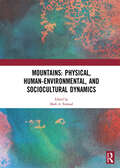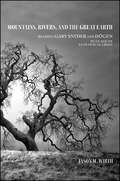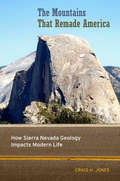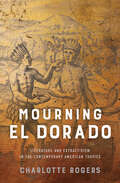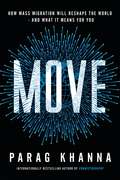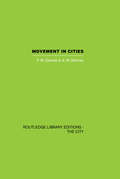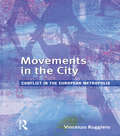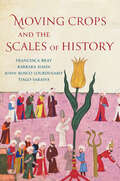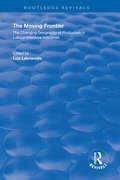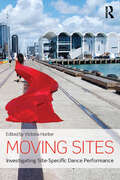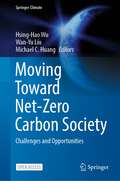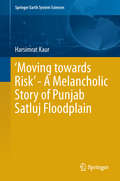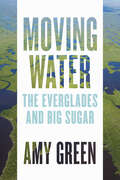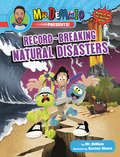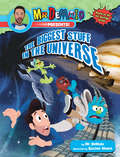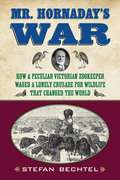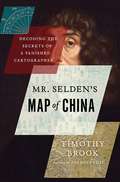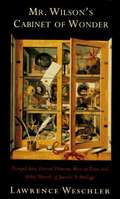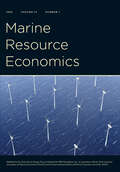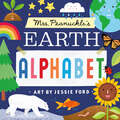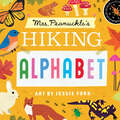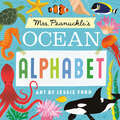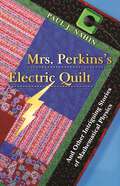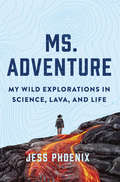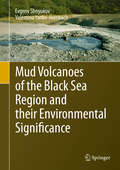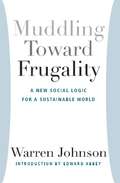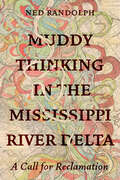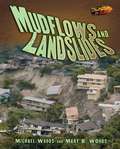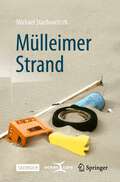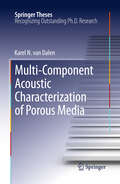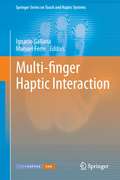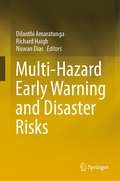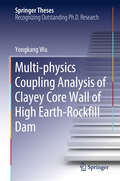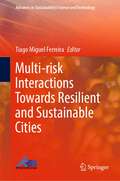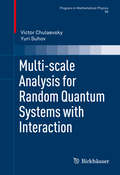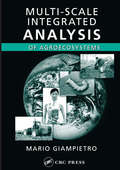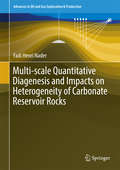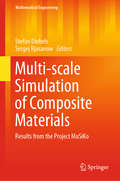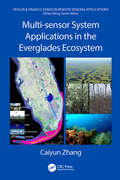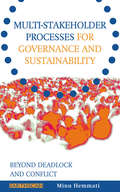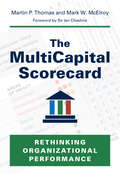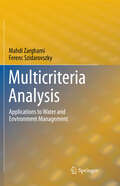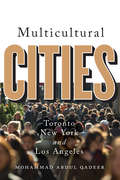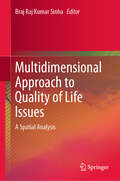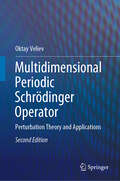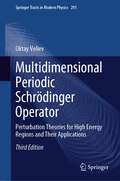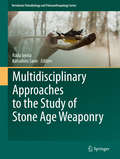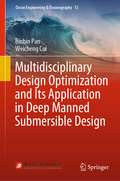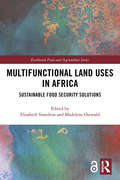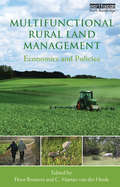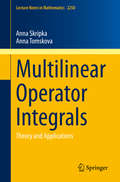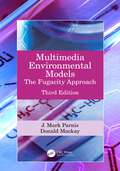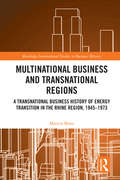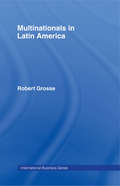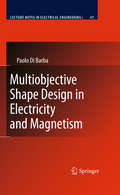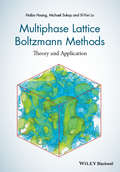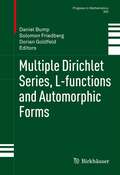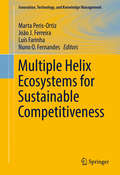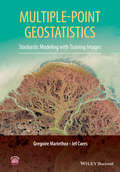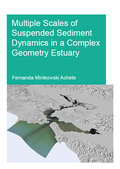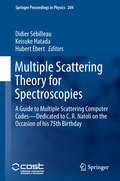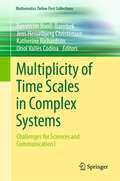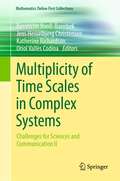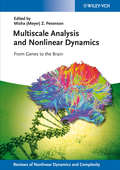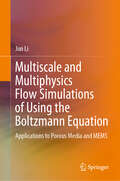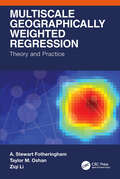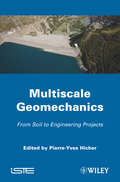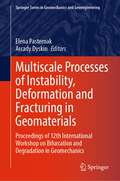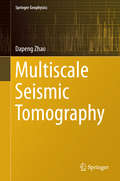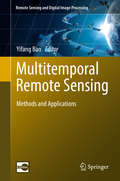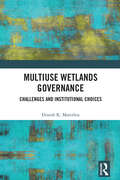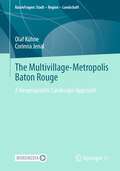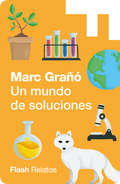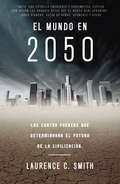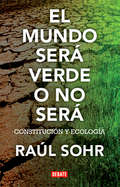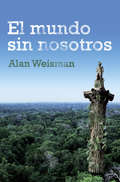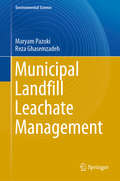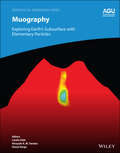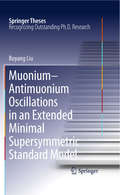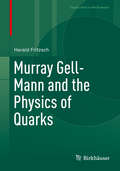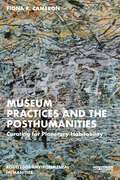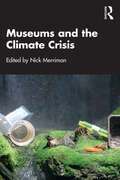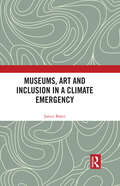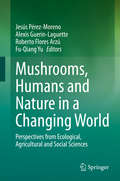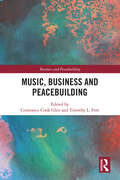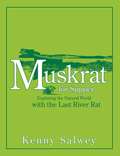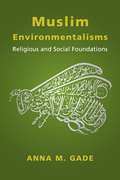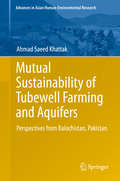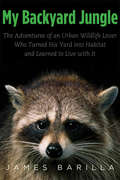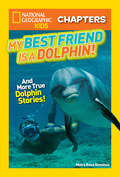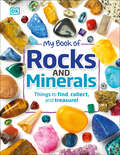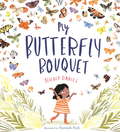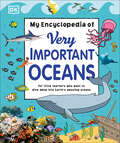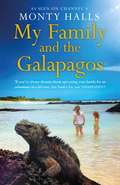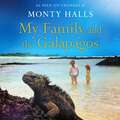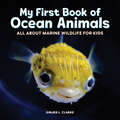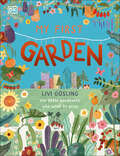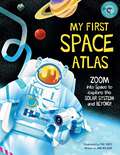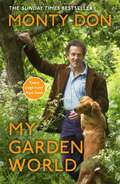- Table View
- List View
Mountains: Physical, Human-Environmental, and Sociocultural Dynamics
by Mark A. FonstadMountains have captured the interests and passions of people for thousands of years. Today, millions of people live within mountain regions, and mountain regions are often areas of accelerated environmental change. This edited volume highlights new understanding of mountain environments and mountain peoples around the world. The understanding of mountain environments and peoples has been a focus of individual researchers for centuries; more recently the interest in mountain regions among researchers has been growing rapidly. The articles contained within are from a wide spectrum of researchers from different parts of the world who address physical, political, theoretical, social, empirical, environmental, methodological, and economic issues focused on the geography of mountains and their inhabitants. The articles in this special issue are organized into three themed sections with very loose boundaries between themes: (1) physical dynamics of mountain environments, (2) coupled human–physical dynamics, and (3) sociocultural dynamics in mountain regions. This book was first published as a special issue of the Annals of the American Association of Geographers.
Mountains, Rivers, and the Great Earth: Reading Gary Snyder and Dōgen in an Age of Ecological Crisis (SUNY series in Environmental Philosophy and Ethics)
by Jason M. WirthFINALIST for the 2017 Foreword INDIES Book of the Year Award in the Philosophy categoryMeditating on the work of American poet and environmental activist Gary Snyder and thirteenth-century Japanese Zen Master Eihei Dōgen, Jason M. Wirth draws out insights for understanding our relation to the planet's ongoing ecological crisis. He discusses what Dōgen calls "the Great Earth" and what Snyder calls "the Wild" as being comprised of the play of waters and mountains, emptiness and form, and then considers how these ideas can illuminate the spiritual and ethical dimensions of place. The book culminates in a discussion of earth democracy, a place-based sense of communion where all beings are interconnected and all beings matter. This radical rethinking of what it means to inhabit the earth will inspire lovers of Snyder's poetry, Zen practitioners, environmental philosophers, and anyone concerned about the global ecological crisis.
The Mountains That Remade America: How Sierra Nevada Geology Impacts Modern Life
by Craig H. JonesFrom ski towns to national parks, fresh fruit to environmental lawsuits, the Sierra Nevada has changed the way Americans live. Whether and where there was gold to be mined redefined land, mineral, and water laws. Where rain falls (and where it doesn’t) determines whose fruit grows on trees and whose appears on slot machines. All this emerges from the geology of the range and how it changed history, and in so doing, changed the country. The Mountains That Remade America combines geology with history to show how the particular forces and conditions that created the Sierra Nevada have effected broad outcomes and influenced daily life in the United States in the past and how they continue to do so today. Drawing connections between events in historical geology and contemporary society, Craig H. Jones makes geological science accessible and shows the vast impact this mountain range has had on the American West.
Mourning El Dorado: Literature and Extractivism in the Contemporary American Tropics (New World Studies)
by Charlotte RogersWhat ever happened to the legend of El Dorado, the tale of the mythical city of gold lost in the Amazon jungle? Charlotte Rogers argues that El Dorado has not been forgotten and still inspires the reckless pursuit of illusory wealth. The search for gold in South America during the colonial period inaugurated the "promise of El Dorado"—the belief that wealth and happiness can be found in the tropical forests of the Americas. That assumption has endured over the course of centuries, still evident in the various modes of natural resource extraction, such as oil drilling and mining, that characterize the region today.Mourning El Dorado looks at how fiction from the American tropics written since 1950 engages with the promise of El Dorado in the age of the Anthropocene. Just as the golden kingdom was never found, natural resource extraction has not produced wealth and happiness for the peoples of the tropics. While extractivism enriches a few outsiders, it results in environmental degradation and the subjugation, displacement, and forced assimilation of native peoples. This book considers how the fiction of five writers—Alejo Carpentier, Wilson Harris, Mario Vargas Llosa, Álvaro Mutis, and Milton Hatoum—criticizes extractive practices and mourns the lost illusion of the forest as a place of wealth and happiness.
Move: How Mass Migration Will Reshape the World – and What It Means for You
by Parag KhannaWhere will you live in 2030? Where will your children settle in 2040? What will the map of humanity look like in 2050?In the 60,000 years since people began colonising the continents, a recurring feature of human civilisation has been mobility - the constant search for resources and stability. Seismic global events - wars and genocides, revolutions and pandemics - have only accelerated the process. The map of humanity isn't settled, not now, not ever.As climate change tips toward full-blown crisis, economies collapse, governments destabilise and technology disrupts, we're entering a new age of mass migrations - one that will scatter both the dispossessed and the well-off. Which areas will people abandon and where will they resettle? Which countries will accept or reject them? As today's world population, which includes four billion restless youth, votes with their feet, what map of human geography will emerge?Here global strategy advisor Parag Khanna provides an illuminating and authoritative vision of the next phase of human civilisation - one that is both mobile and sustainable. As the book explores, in the years ahead people will move to where the resources are and technologies will flow to the people who need them, returning us to our nomadic roots while building more secure habitats. Move is a fascinating look at the deep trends that are shaping the most likely scenarios for the future. Most importantly, it guides each of us as we determine our optimal location on humanity's ever-changing map.
Movement in Cities: Spatial Perspectives On Urban Transport And Travel
by P.W. Daniels A.M. WarnesMovement in Cities describes and analyses urban travel in terms of purpose, distance and frequency of journeys and modes and routes used, concentrating mainly on British towns with many references to the United States and Australia. The authors elucidate the all-important interrelations between location of activities and the patterns of transport supply and use within towns. The issues they raise are of pressing practical and intellectual importance. This book was first published in 1980.
Movements in the City: Conflict in the European Metropolis
by Vincenzo RuggieroFor 2nd and 3rd year courses in urban sociology, sociology of exclusion, social stratification, planning and cultural studies in departments of sociology and urban geography. This book provides an in depth examination of social movements and urban life in European cities today. Unique in its interdisciplinary approach, it covers traditional areas of urban studies, sociological concerns about the concept of change and the characteristics of social movements. It presents current theory as well as discursive sections based around empirical work conducted in major European cities including London, Paris and Berlin.
Moving Crops and the Scales of History (Yale Agrarian Studies Series)
by Francesca Bray Barbara Hahn John Bosco LourdusamyA bold redefinition of historical inquiry based on the “cropscape”—the people, creatures, technologies, ideas, and places that surround a crop Human efforts to move crops from one place to another have been a key driving force in history. Crops have been on the move for millennia, from wildlands into fields, from wetlands to dry zones, from one imperial colony to another. This book is a bold but approachable attempt to redefine historical inquiry based on the “cropscape”: the assemblage of people, places, creatures, technologies, and other elements that form around a crop. The cropscape is a method of reconnecting the global with the local, the longue durée with microhistory, and people, plants, and places with abstract concepts such as tastes, ideas, skills, politics, and economic forces. Through investigating a range of contrasting cropscapes spanning millennia and the globe, the authors break open traditional historical structures of period, geography, and direction to glean insight into previously invisible actors and forces.
The Moving Frontier: The Changing Geography of Production in Labour-Intensive Industries (Routledge Revivals)
by Lois LabrianidisOriginally published in 1992 and based on two theoretical approaches: the Global Commodity Chain and the Global Production Network, this book investigates the multitude of processes, as well as diverse consequences of global integration upon industries, regions, enterprises and employees. In doing so, it draws from the experience of Western and Eastern and South-eastern Europe. These European cases are complemented with evidence from Kenya, Thailand as well as US, China, India and Mexico. The book explores multiple causes of decentralization, arguing beyond the pursuit of cheap and adaptable labour. It goes on to argue that the effects of delocalization within Europe, unlike those in the rest of the developed world, are less negative than usually portrayed. It concludes by putting forward recommendations for best future practice of successful adjustment strategies and examines how these might be adopted elsewhere in the world.
Moving Sites: Investigating Site-Specific Dance Performance
by Victoria HunterMoving Sites explores site-specific dance practice through a combination of analytical essays and practitioner accounts of their working processes. In offering this joint effort of theory and practice, it aims to provide dance academics, students and practitioners with a series of discussions that shed light both on approaches to making this type of dance practice, and evaluating and reflecting on it. The edited volume combines critical thinking from a range of perspectives including commentary and observation from the fields of dance studies, human geography and spatial theory in order to present interdisciplinary discourse and a range of critical and practice-led lenses through which this type of work can be considered and explored. In so doing, this book addresses the following questions: · How do choreographers make site-specific dance performance? · What occurs when a moving body engages with site, place and environment? · How might we interpret, analyse and evaluate this type of dance practice through a range of theoretical lenses? · How can this type of practice inform wider discussions of embodiment, site, space, place and environment? This innovative and exciting book seeks to move beyond description and discussion of site-specific dance as a spectacle or novelty and considers site-dance as a valid and vital form of contemporary dance practice that explores, reflects, disrupts, contests and develops understandings and practices of inhabiting and engaging with a range of sites and environments. Dr Victoria Hunter is Senior Lecturer in Dance at the University of Chichester.
Moving Toward Net-Zero Carbon Society: Challenges and Opportunities (Springer Climate)
by Hsing-Hao Wu Wan-Yu Liu Michael C. HuangThis open access book explores various issues concerning the net-zero emission achievement, ranging from carbon pricing, carbon trade schemes, energy transition, ecological conservation, and carbon sinks, as well as the economic and social impacts of introducing carbon neutral policies in the Asia-Pacific region. The extreme flooding and drought problems, crop yield problems, and habitat changes brought about by climate change have seriously threatened the ecosystem and human survival, forcing people to rethink environmental management policies and limits on economic development. In the post-COVID-10 era, it is indispensable to adopt a more proactive climate change adaptation policy and establish bilateral cooperation with international partners who value climate change. 2021 is a critical year, and the leaders of major industrial countries at the recently concluded G7 meeting jointly stated the common objective seeking the establishment of carbon-neutral international community by the mid of the century. Major carbon-emitting countries or entities such as the European Union, US, Japan, Korea, China, and India have proposed specific timetables for net-zero carbon emissions and carbon neutrality before or at the COP26. Policy-makers around the world would also work closely with scientists, experts, and enterprises seeking appropriate policy instruments such as the development of carbon tax, carbon pricing, carbon sinks, global or regional carbon emission trade schemes, energy transitions, and other carbon-neutral policies moving toward net-zero emission society by the mid of the century. At a time when carbon pricing policies are being formulated, climate change related laws and policies will reshape the global governance and industrial layout during the period of 2021–-2030, and it is critical to move toward energy and industrial transformation, ecological conservation, and sustainable agricultural development.
‘Moving towards Risk’ - A Melancholic Story of Punjab Satluj Floodplain (Springer Earth System Sciences)
by Harsimrat KaurThis book explains the tragic tale of the Satluj floodplain since its inception. As a landscape this floodplain entity evolves and sets a niche to distinctive natural and cultural aspects. The historical reconstruction of the landscape transformation depicts the excessive human encroachment and development activities which leads to more than fifty percent of landscape transformation. Data set layers were generated in a geospatial environment, with the use of multiscale and multitemporal satellite imageries, empirical field verification, and ancillary data input. An integrated landscape model was hence formed in order to identify the causal links between natural and cultural aspects.The author shows a landscape transformation matrix and change detection maps to explain the spatial trends and patterns of land use and land cover change. Pixel wise land use and land cover gain-loss algorithm were identified and measured for a selected time period. Changing spatial pattern of land cover to land use ratio are explained with underlying local to regional level causes. The author thoroughly explains the satellite image interpretation and related methodology. This book provides the detailed transition journey of landscape conversion from resource rich natural entity to a human dominated ‘hazardscape’. It also explains how the expansion of population and related activities in the close vicinity of an active floodplain accentuates the problem of flood risks and how it affects the human and livestock life and creates economic loss. The author maps and explains the vector and magnitude of increased human pressure on the landscape and its adverse ecological implications, and describes issues with reference to the hazard status of the Punjab Satluj floodplain, including increased flood risk, increased pressure on agricultural land and depletion of resources, loss of biodiversity, qualitative and quantitative loss to surface and sub-surface water, and soil degradation (soil erosion, waterlogging and soil loss).Recommendations are provided with a detailed provision of potential applications with the underlying agenda of further conversion of this ecologically highly vulnerable flood prone ‘hazardscape’ to a Green Habitat. This book consist of two major themes: land use/land cover change and floodplain. The author answers all the geographical questions (what, where, when, why and how) related with both themes and provides an outlook to potential future prospects. The book is targeted at stakeholders, students, researchers and policy makers to optimize their interest and to guide them towards a positive charge in sustainable resource management through suitable and best possible sustainable utilization of landscape.
Moving Water: The Everglades and Big Sugar
by Amy GreenA riveting story of environmental disaster and political intrigue, Moving Water exposes how Florida's clean water is threatened by dirty power players and the sugar cane industry.Only a century ago, nearly all of South Florida was under water. The Everglades, one of the largest wetlands in the world, was a watery arc extending over 3 million acres. Today, that wetland ecosystem is half of its former self, supplanted by housing for the region's exploding population and over 700,000 acres of crops, including the nation's largest supply of sugar cane. Countless canals, dams, and pump stations keep the trickle flowing, but rarely address the cascade of environmental consequences, including dangerous threats to a crucial drinking water source for a full third of Florida's residents. In Moving Water, environmental journalist Amy Green explores the story of unlikely conservation heroes George and Mary Barley, wealthy real estate developers and champions of the Everglades, whose complicated legacy spans from fisheries in Florida Bay to the political worlds of Tallahassee and Washington. At the center of their surprising saga is the establishment and evolution of the Comprehensive Everglades Restoration Plan (CERP), a $17 billion taxpayer-funded initiative aimed at reclaiming this vital ecosystem. Green explains that, like the meandering River of Grass, the progress of CERP rarely runs straight, especially when it comes up against the fierce efforts of sugar-growing interests, or "Big Sugar," to obstruct the cleanup of fertilizer runoff wreaking havoc with restoration. This engrossing exposé tackles some of the most important issues of our time: Is it possible to save a complex ecosystem such as the Everglades—or, once degraded, are such ecological wonders gone forever? What kind of commitments—economic, scientific, and social—will it take to rescue our vulnerable natural resources? What influences do special interests wield in our everyday lives, and what does it take to push real reform through our democracy? A must-read for anyone fascinated by stories of political intrigue and the work of environmental crusaders like Erin Brockovich, as well as anyone who cares about the future of Florida, this book reveals why the Everglades serve as a model—and a warning—for environmental restoration efforts worldwide.
Mr. DeMaio Presents!: Based on the Hit YouTube Series!
by Mike DeMaioMr. DeMaio Presents! = STEM + (Jokes x Fun) --Publishers WeeklyFollow along with Mr. DeMaio and his comical crew as they explore the world and beyond in search of the most destructive disasters to date!Hurricanes, tornadoes, tsunamis ... oh my! In the first installment of the Mr. DeMaio Presents! series, YouTube sensation Mr. DeMaio and his crew unearth all the facts for record-breaking natural disasters that have occured on planet Earth ... and even a few in outer space! With full color photographs and illustrations, this book from popular YouTuber (over 290k subscribers) and science teacher Mr. DeMaio will keep kids entertained while educating!
Mr. DeMaio Presents!: Based on the Hit YouTube Series!
by Mike DeMaioMr. DeMaio Presents! = STEM + (Jokes x Fun) --Publishers WeeklyFollow along with Mr. DeMaio and his comical crew as they explore the world and beyond in search of the biggest stuff in the universe!Mega space volcanoes...super-giant asteroids...a twenty-six-pound gummy bear? In the second installment of the Mr. DeMaio Presents! series, the crew is traveling across the galaxy in search of the biggest stuff in the universe...even if that means a sugary piece of candy that weighs more than three bowling balls! With full color photographs and illustrations, this book from popular YouTuber (over 290k subscribers) and science teacher Mr. DeMaio will keep kids entertained while educating!
Mr. Hornaday's War: How a Peculiar Victorian Zookeeper Waged a Lonely Crusade for Wildlife That Changed the World
by Stefan BechtelHe was complex, quirky, pugnacious, and difficult. He seemed to create enemies wherever he went, even among his friends. A fireplug of a man who stood only five feet eight inches in his stocking feet, he had an outsized ambition to make his mark on the world. And he did. William Temple Hornaday (1854-1937) was probably the most famous conservationist of the nineteenth century, second only to his great friend and ally Theodore Roosevelt. Hornaday's great passion was protecting wild things and wild places, and he spent most of his adult life in a state of war on their behalf, as a taxidermist and museum collector; as the founder and first director of the National Zoo in Washington, DC; as director of the Bronx Zoo for thirty years; and as the author of nearly two dozen books on conservation and wildlife. But in Mr. Hornaday's War, the long-overdue biography of Hornaday by journalist Stefan Bechtel, the grinding contradictions of Hornaday's life also become clear. Though he is credited with saving the American bison from extinction, he began his career as a rifleman and trophy hunter who led "the last buffalo hunt" into the Montana Territory. And what happened in 1906 at the Bronx Zoo, when Hornaday displayed an African man in a cage, shows a side of him that is as baffling as it is repellent. This gripping new book takes an honest look at a fascinating and enigmatic man.
Mr. Selden's Map of China: Decoding the Secrets of a Vanished Cartographer
by Timothy BrookSelected for The Globe 100 Books in 2013. A fascinating work of history, biography, cartography, and literary mystery, Mr Selden’s Map of China unlocks the secrets behind a recently discovered map of China like no other of its time. In 1659, a vast and unusual map of China arrived in the Bodleian Library, Oxford. It was bequeathed by John Selden, a London business lawyer, political activist, former convict, MP, and the city’s first Orientalist scholar. Largely ignored, it remained in the bowels of the library, until called up by an inquisitive reader. When Timothy Brook saw it in 2009, he realized that the Selden Map was “a puzzle that had to be solved”: an exceptional artefact so unsettlingly modern-looking it could almost be a forgery. But it was genuine, and what it has to tell us is astonishing. It shows China, not cut off from the world, but a participant in the embryonic networks of global trade that fuelled the rise of Europe — and now power China’s ascent. And it raises as many question as it answers: How did John Selden acquire it? Where did it come from? Who re-imagined the world in this way and, most importantly, what can it tell us about the world at that time? Like a cartographic detective, award-winning author and historian Timothy Brook has provided answers. From the Gobi Desert to the Philippines, from Java to Tibet, and into China itself, Brook uses the map to tease out the varied elements that defined this crucial period in China’s history.
Mr. Wilson's Cabinet of Wonder: Pronged Ants, Horned Humans, Mice on Toast, and Other Marvels of Jurassic Technology
by Lawrence WeschlerWriting with great style and humor, Weschler guides the readers through the Museum of Jurassic Technology and through the mind of its curator, David Wilson, a man of unusual imagination who mounts exhibits such as spore-inhaling ants, bats deploying ultraviolet frequencies, peach-pit carvings, and other exhibits that seem the manifest definition of bizarre.
MRE vol 35 num 1
by The University of Chicago PressThis is volume 35 issue 1 of Marine Resource Economics. Marine Resource Economics (MRE) publishes creative and scholarly economic analyses of a range of issues related to natural resource use in the global marine environment. The scope of the journal includes conceptual and empirical investigations aimed at addressing real-world ocean and coastal policy problems. MRE is an outlet for early results and imaginative new thinking on emerging topics in the marine environment, as well as rigorous theoretical and empirical analyses of questions that have long interested economists who study the oceans. A pluralistic forum for researchers and policy makers, MRE encourages challenges to conventional paradigms and perspectives. The journal is comprised of five sections: Articles, Perspectives, Case Studies, Systematic Reviews, and Book Reviews.
Mrs. Peanuckle's Earth Alphabet (Mrs. Peanuckle's Alphabet #9)
by Mrs. PeanuckleExplore our wondrous planet while learning the ABCs with Mrs. Peanuckle! With playful text, bright illustrations, and sturdy pages, this alphabet book will engage toddlers, and take them on an alphabet adventure through the natural world!Mrs. Peanuckle shares everything that makes Earth so special—and all the important ways we can protect our home from climate change in her latest tour of the ABCs! From A to Z, Mrs. Peanuckle introduces toddlers to 26 different natural-world experiences. With bold, colorful pages, strong graphic art, and exciting design, these simple nature words are sure to be a hit with budding environmentalists and curious young scientists.Collect all of Mrs. Peanuckle's Alphabet books, including: KitchenHikingBirdTreeBugFlowerFruitVegetable
Mrs. Peanuckle's Hiking Alphabet
by Mrs. PeanuckleWith playful text, bright illustrations, and sturdy pages, Mrs. Peanuckle's alphabet books will engage toddlers, and take them on an alphabet adventure through the natural world!Explore the wondrous world of hiking while learning the ABCs with Mrs. Peanuckle! Mrs. Peanuckle takes on the outdoors and shares all her favorite animals, plants, and more in her latest tour of the ABCs! From A to Z, Mrs. Peanuckle introduces toddlers to 26 different natural-world experiences. With bold, colorful pages, strong graphic art, and exciting design, these simple nature words are sure to be a hit with budding hikers and curious young scientists. Collect all of Mrs. Peanuckle's Alphabets, including: Kitchen, Hiking, Bird, Tree, Bug, Flower, Fruit, and Vegetable!
Mrs. Peanuckle's Ocean Alphabet (Mrs. Peanuckle's Alphabet #10)
by Mrs. PeanuckleMrs. Peanuckle's alphabet books engage toddlers with interesting and informative words, graphic art, and sturdy pages!From A to Z, Mrs. Peanuckle introduces toddlers to words about the earth's oceans. These simple nature words are sure to be a hit with budding biologists, curious young environmentalists, and parents and teachers who want to encourage learning and an awareness of our unique planet! Collect all of Mrs. Peanuckle's Alphabet books, including Fruit, Vegetable, Bug, Flower, Bird, Tree, Hiking, Kitchen, and Earth!
Mrs. Perkins's Electric Quilt: And Other Intriguing Stories of Mathematical Physics
by Paul J. NahinAn incomparable collection of stimulating math puzzles from bestselling author Paul NahinWhat does quilting have to do with electric circuit theory? The answer is just one of the fascinating ways that best-selling popular math writer Paul Nahin illustrates the deep interplay of math and physics in the world around us in his latest book of challenging mathematical puzzles, Mrs. Perkins's Electric Quilt. With his trademark combination of intriguing mathematical problems and the historical anecdotes surrounding them, Nahin invites readers on an exciting and informative exploration of some of the many ways math and physics combine to create something vastly more powerful, useful, and interesting than either is by itself.In a series of brief and largely self-contained chapters, Nahin discusses a wide range of topics in which math and physics are mutually dependent and mutually illuminating, from Newtonian gravity and Newton's laws of mechanics to ballistics, air drag, and electricity. The mathematical subjects range from algebra, trigonometry, geometry, and calculus to differential equations, Fourier series, and theoretical and Monte Carlo probability. Each chapter includes problems—some three dozen in all—that challenge readers to try their hand at applying what they have learned. Just as in his other books of mathematical puzzles, Nahin discusses the historical background of each problem, gives many examples, includes MATLAB codes, and provides complete and detailed solutions at the end.Mrs. Perkins's Electric Quilt will appeal to students interested in new math and physics applications, teachers looking for unusual examples to use in class—and anyone who enjoys popular math books.
Ms. Adventure: My Wild Explorations in Science, Lava, and Life
by Jess Phoenix"Jess Phoenix's work encompasses science and representation in such a delightful melding that it could only come from as spry and playful a soul as hers! Open this book and jump into the volcano!" —Patton Oswalt As a volcanologist, natural hazards expert, and founder of Blueprint Earth, Jess Phoenix has dedicated her life to scientific exploration. Her career path—hard earned in the male-dominated world of science—has led her into still-flowing Hawaiian lava fields, congressional races, glittering cocktail parties at Manhattan&’s elite Explorers Club, and numerous pairs of Caterpillar work boots. It has also inspired her to devote her life to making science more inclusive and accessible. Ms. Adventure skillfully blends personal memoir, daring adventure, and scientific exploration, following Phoenix&’s journey from reality television sites deep in Ecuadorian jungles to Andean glaciers, university classrooms to Death Valley in summer. She has even chased down members of a Mexican cartel to retrieve a stolen favorite rock hammer. Readers will delight in her unbelievable adventures, all embarked on for the love of science.
Mud Volcanoes of the Black Sea Region and their Environmental Significance
by Evgeny Shnyukov Valentina Yanko-HombachThis exceptionally well-illustrated book at a high scientific level describes mud volcanism as a complex, multidimensional phenomenon requiring multidisciplinary study. Mud volcanoes can be used as “cheap windows” to search for gas-hydrates and other mineral resources in the Black Sea region. Nothing similar has been published before, and as one of its unique features the book includes a vast amount of new data unavailable so far to the western reader. The book includes new data on driving forces, mechanisms, origin, geological and geomorphological features of mud volcanoes as well as new data on composition of solid, gaseous, and liquid components of erupted material. It covers a wide geographic region, and its subjects range from geological to environmental to industrial applications.
Muddling Toward Frugality
by Warren JohnsonMr. Johnson's thesis can be summarized without much difficulty: after generations of extravagant and reckless industrial expansion, we are clearly entering an age of economic scarcity. While human demands continue to rise, natural resources, especially the non-renewable kind, become harder to find and more expensive to extract, process, transport and distribute. This simple brute fact is the basic cause of inflation, despite the inability of most professional economists to see it. (The "dismal science" has never been more dismally obtuse than it is today.) The law of diminishing returns is coming into effect. Technological developments can delay the process but not halt or reverse it; nor can we rely on government or big business to save us. Planning for further growth delays the adjustments that must be made, makes a fair sharing of necessary sacrifices more troublesome, and if carried too far will make more severe and painful, because rapid, the inevitable decline of the international economic machine. The best way to deal with the end of affluence is to accept it-not fight it-and to begin, here and now, the unavoidable adaptations, on an individual, family, and community basis. Piecemeal, experimental, and muddling.
Muddy Thinking in the Mississippi River Delta: A Call for Reclamation
by Ned RandolphA free ebook version of this title is available through Luminos, University of California Press's Open Access publishing program. Visit www.luminosoa.org to learn more.Muddy Thinking in the Mississippi River Delta uses the story of mud to answer a deceptively simple question: How can a place uniquely vulnerable to sea level rise be one of the nation's most promiscuous producers and consumers of fossil fuels? Organized around New Orleans and South Louisiana as a case study, this book examines how the unruly Mississippi River and its muddy delta shaped the people, culture, and governance of the region. It proposes a framework of "muddy thinking" to gum the wheels of extractive capitalism and pollution that have brought us to the precipice of planetary collapse. Muddy Thinking calls upon our dirty, shared histories to address urgent questions of mutual survival and care in a rapidly changing world.
Mudflows and Landslides
by Michael Woods Mary B. WoodsImagine that you hear a faint rumbling sound coming from a hillside. the noise gets louder, and when you turn to look, a river of mud is flowing toward you! Big mudflows and landslides can happen unexpectedly, causing terrible disasters. the moving mass of soil and rock carries away people, animals, houses, cars, bridges, trees, and anything else in its path. with dramatic images and firsthand survivor stories--plus the latest facts and figures--this book shows you some of the world's biggest mudflow and landslide disasters up close.
Mülleimer Strand
by Michael StachowitschDieses reich illustrierte Buch ist der ideale Führer zu den Gegenständen, die an den Stränden der Welt herumliegen. Vergessen Sie Muscheln und andere Fauna und Flora. Hier finden Sie, was ein Strandbesucher heutzutage am ehesten antreffen kann: Glas, Plastik, Holz, Metall, Papier, Öl und andere Quellen der Meeresverschmutzung!Mit fast 700 Fotos zeigt dieser Leitfaden die ganze Bandbreite der Müllgegenstände im Meer, die jeweils mit einem Augenzwinkern und einer Prise Humor vorgestellt werden. Darüber hinaus liefert der Autor ausführliche Informationen zu diesen Gegenständen. Sie werden alles Wissenswerte über sie erfahren. Dazu gehören nicht nur ihre Herkunft und ihre Zersetzungsstadien. Sie erfahren, welche Bedrohung die einzelnen Gegenstände für diese wunderschöne Umwelt darstellen, und erhalten Informationen über Präventionsstrategien, Empfehlungen für die Reinigung, alternative Produkte sowie Recycling- und Upcycling-Ideen. Neben dem ästhetischen Aspekt stellt der Müll im Meer auch eine Bedrohung für die Tierwelt, die menschliche Gesundheit und das wirtschaftliche Wohlergehen dar. Dieses Buch gibt Ihnen das nötige Wissen an die Hand, um diese schändlichen und oft gefährlichen Schandflecke zu bekämpfen. Werden Sie ein Stranddetektiv! Bereisen Sie mit dieser ultimativen Strandlektüre die beliebtesten Reiseziele der Welt und helfen Sie mit, diese faszinierenden Umgebungen in ihrer natürlichen Schönheit wiederherzustellen.
Multi-Component Acoustic Characterization of Porous Media
by Karel N. van DalenThe feasibility to extract porous medium parameters from acoustic recordings is investigated. The thesis gives an excellent discussion of our basic understanding of different wave modes, using a full-waveform and multi-component approach. Focus lies on the dependency on porosity and permeability where especially the latter is difficult to estimate. In this thesis, this sensitivity is shown for interface-wave and reflected-wave modes. For each of the pseudo-Rayleigh and pseudo-Stoneley interface waves unique estimates for permeability and porosity can be obtained when impedance and attenuation are combined. The pseudo-Stoneley wave is most sensitive to permeability: both the impedance and the attenuation are controlled by the fluid flow. Also from reflected-wave modes unique estimates for permeability and porosity can be obtained when the reflection coefficients of different reflected modes are combined. In this case the sensitivity to permeability is caused by subsurface heterogeneities generating mesoscopic fluid flow at seismic frequencies. The results of this thesis suggest that estimation of in-situ permeability is feasible, provided detection is carried out with multi-component measurements. The results of this thesis argely affect geotechnical and reservoir engineering practices.
Multi-finger Haptic Interaction
by Manuel Ferre Ignacio GalianaMulti-finger Haptic Interaction presents a panorama of technologies and methods for multi-finger haptic interaction, together with an analysis of the benefits and implications of adding multiple-fingers to haptic applications. Research topics covered include: design and control of advanced haptic devices;multi-contact point simulation algorithms;interaction techniques and implications in human perception when interacting with multiple fingers.These multi-disciplinary results are integrated into applications such as medical simulators for training manual skills, simulators for virtual prototyping and precise manipulations in remote environments. Multi-finger Haptic Interaction presents the current and potential applications that can be developed with these systems, and details the systems' complexity. The research is focused on enhancing haptic interaction by providing multiple contact points to the user. This state-of-the-art volume is oriented towards researchers who are involved in haptic device design, rendering methods and perception studies, as well as readers from different disciplines who are interested in applying multi-finger haptic technologies and methods to their field of interest.
Multi-Hazard Early Warning and Disaster Risks
by Dilanthi Amaratunga Richard Haigh Nuwan DiasThis book presents a collection of papers under the theme of multi-hazard early warning and disaster risks. These were selected from the presentations made at the International Symposium on Tsunami and Multi-Hazard Risks, Early Warning and Community Awareness in supporting implementation of the Sendai Framework for Disaster Risk Reduction 2015-2030. This conference aimed to recognize achievements and to highlight work that still needs to be carried out. The conference promoted collaboration among academia, research institutions and disaster management offices, and further encouraged multidisciplinary and multi-sectoral interactionThis International Symposium on Multi-Hazard Early Warning and Disaster Risk Reduction provided an important opportunity to reflect upon our progress to date in tackling disaster risk, but also to consider some of the challenges and opportunities that lay ahead of us.A particular focus of this event wasMulti-Hazard Early Warning. During the negotiations for the Sendai Framework, countries and partners highlighted the need to:1. Continue to invest in, develop, maintain and strengthen people-centred, end-to-end early warning systems;2. Promote the application of simple and low cost early warning equipment and facilities;3. Broaden the dissemination channels for early warning information to facilitate early action.Countries also called for the further development of and investment in effective, nationally compatible, regional multi-hazard early warning mechanisms. To address these needs, global Target (g) of the Sendai Framework was adopted, namely to “substantially increase the availability of and access to multi-hazard early warning systems and disaster risk information and assessments to the people by 2030”. As illustrated by recent events in Indonesia, it is also vital to address the challenge of cascading hazards that pose a tsunami risk, and the importance of linking tsunami early warning to a multi-hazard environment. However, moving towards a multi-hazard environment is complex and poses many challenges but can bring significant benefits in terms of efficiencies and also in recognising the links between hazards, such as cascading threats. We very much hope that this book will provide an important platform to address these and other challenges in addressing disaster risk, as well as supporting implementation of the Sendai Framework for Disaster Risk Reduction
Multi-physics Coupling Analysis of Clayey Core Wall of High Earth-Rockfill Dam (Springer Theses)
by Yongkang WuNominated by Tsinghua University as an outstanding Ph.D. thesis, this book investigates the mechanical properties of unsaturated compacted clayey soil, the multi-field coupling consolidation theory of unsaturated soil and its application to a 261.5 m high earth-rockfill dam. It proposes a multi-field coupling analysis method of consolidation, and develops an efficient and practical finite element (FE) program for large-scale complex earth-rockfill dams. The book is primarily intended for researchers studying the multi-field coupling analysis of seepage consolidation.
Multi-risk Interactions Towards Resilient and Sustainable Cities (Advances in Sustainability Science and Technology)
by Tiago Miguel FerreiraFor years, researchers have studied the risks of individual natural hazards in urban areas. However, the impact of multiple hazards has not yet received widespread attention in research and urban management practice, which is a significant gap in the current climate change context. This book aims to contribute to filling that gap by examining the process of identifying, assessing, and managing multi-hazard risks in urban areas. From identifying and assessing the vulnerability of the elements exposed to the impact of natural hazards, including earthquakes, floods, fires, and landslides, this book covers all the critical stages of multi-hazard risk assessment and management in a climate change context. The concepts and approaches discussed in the book are applied to the Lisbon Metropolitan Area, a dynamic and thriving metropolis, allowing readers to see those theories applied in a real setting. In addition to providing a solid theoretical foundation, this book offers practical guidelines for conducting risk assessment at the metropolitan scale, which makes it a valuable resource for researchers, practitioners, and decision-makers interested in understanding and managing multi-hazard risks in urban areas.
Multi-scale Analysis for Random Quantum Systems with Interaction
by Victor Chulaevsky Yuri SuhovThe study of quantum disorder has generated considerable research activity in mathematics and physics over past 40 years. While single-particle models have been extensively studied at a rigorous mathematical level, little was known about systems of several interacting particles, let alone systems with positive spatial particle density. Creating a consistent theory of disorder in multi-particle quantum systems is an important and challenging problem that largely remains open. Multi-scale Analysis for Random Quantum Systems with Interaction presents the progress that had been recently achieved in this area. The main focus of the book is on a rigorous derivation of the multi-particle localization in a strong random external potential field. To make the presentation accessible to a wider audience, the authors restrict attention to a relatively simple tight-binding Anderson model on a cubic lattice Zd. This book includes the following cutting-edge features: an introduction to the state-of-the-art single-particle localization theory an extensive discussion of relevant technical aspects of the localization theory a thorough comparison of the multi-particle model with its single-particle counterpart a self-contained rigorous derivation of both spectral and dynamical localization in the multi-particle tight-binding Anderson model. Required mathematical background for the book includes a knowledge of functional calculus, spectral theory (essentially reduced to the case of finite matrices) and basic probability theory. This is an excellent text for a year-long graduate course or seminar in mathematical physics. It also can serve as a standard reference for specialists.
Multi-Scale Integrated Analysis of Agroecosystems (Advances In Agroecology Ser.)
by Mario GiampietroEcologists, agronomists, and others who may question the validity of current models for determining sustainable growth of agroecosystems, need a new set of analytical tools that more effectively address the complex nature of related processes. Those who challenge traditional assumptions of optimization and static factors in agricultural modeling de
Multi-scale Quantitative Diagenesis and Impacts on Heterogeneity of Carbonate Reservoir Rocks
by Fadi Henri NaderThis book is both a review and a look to the future, highlighting challenges for better predicting quantitatively the impact of diagenesis on reservoir rocks. Classical diagenesis studies make use of a wide range of descriptive analytical techniques to explain specific, relatively time-framed fluid-rock interaction processes, and deduce their impacts on reservoir rocks. Future operational workflows will consist of constructing a conceptual diagenesis model, quantifying the related diagenetic phases, and modelling the diagenetic processes. Innovative approaches are emerging for applied quantitative diagenesis, providing numerical data that can be used by reservoir engineers as entry (input) data, and for validating results of numerical simulations. Geometry-based, geostatistical and geochemical modelling do not necessarily mimic natural processes, they rather provide reasonable solutions to specific problems.
Multi-scale Simulation of Composite Materials: Results from the Project MuSiKo (Mathematical Engineering)
by Stefan Diebels Sergej RjasanowDue to their high stiffness and strength and their good processing properties short fibre reinforced thermoplastics are well-established construction materials.Up to now, simulation of engineering parts consisting of short fibre reinforced thermoplastics has often been based on macroscopic phenomenological models, but deformations, damage and failure of composite materials strongly depend on their microstructure. The typical modes of failure of short fibre thermoplastics enriched with glass fibres are matrix failure, rupture of fibres and delamination, and pure macroscopic consideration is not sufficient to predict those effects. The typical predictive phenomenological models are complex and only available for very special failures. A quantitative prediction on how failure will change depending on the content and orientation of the fibres is generally not possible, and the direct involvement of the above effects in a numerical simulation requires multi-scale modelling.One the one hand, this makes it possible to take into account the properties of the matrix material and the fibre material, the microstructure of the composite in terms of fibre content, fibre orientation and shape as well as the properties of the interface between fibres and matrix. On the other hand, the multi-scale approach links these local properties to the global behaviour and forms the basis for the dimensioning and design of engineering components. Furthermore, multi-scale numerical simulations are required to allow efficient solution of the models when investigating three-dimensional problems of dimensioning engineering parts.Bringing together mathematical modelling, materials mechanics, numerical methods and experimental engineering, this book provides a unique overview of multi-scale modelling approaches, multi-scale simulations and experimental investigations of short fibre reinforced thermoplastics. The first chapters focus on two principal subjects: the mathematical and mechanical models governing composite properties and damage description. The subsequent chapters present numerical algorithms based on the Finite Element Method and the Boundary Element Method, both of which make explicit use of the composite’s microstructure. Further, the results of the numerical simulations are shown and compared to experimental results.Lastly, the book investigates deformation and failure of composite materials experimentally, explaining the applied methods and presenting the results for different volume fractions of fibres.This book is a valuable resource for applied mathematics, theoretical and experimental mechanical engineers as well as engineers in industry dealing with modelling and simulation of short fibre reinforced composites.
Multi-sensor System Applications in the Everglades Ecosystem (Remote Sensing Applications Series)
by Caiyun ZhangThis book explores the applicability of multiple remote sensors to acquire information relevant to restoration and conservation efforts in wetlands using data collected from airborne and space multispectral/hyperspectral sensors, light detection and ranging (LiDAR), Unmanned Aircraft Systems (UAS), and a hand-held spectroradiometer. This book also examines digital data processing techniques such as object-based image analysis, machine learning, texture analysis, and data fusion. After an introduction to the Everglades and to remote sensing, the book is divided into four parts based on the sensor systems used. There are chapters on vegetation mapping, biomass and water quality modeling, applications of hyperspectral data for plant stress analysis and coral reef mapping, studies of airborne LiDAR data for coastal vulnerability analysis and DEM improvement, as well as chapters that explore a fusion of multiple sensors for different datasets. <p><p>Features <li>Introduces concepts, theories, and advanced processing techniques <li>A complete introduction of machine learning, object-based image analysis, data fusion, and ensemble analysis techniques in processing data from multiple remote sensors <li>Explains how multiple remote sensing systems are applied in the wetland ecosystems of Florida <li>The author had been teaching and using both systems and her research is widely recognized <p><p>Multi-sensor System Applications in the Everglades Ecosystems provides a comprehensive application of remote sensing techniques in the Florida Everglades and its coastal ecosystems. It will prove an invaluable resource for the restoration and conservation of the Florida Everglades and beyond, for global wetlands in general. Any professional, scientist, engineer, or student working with remote sensing and wetland ecosystems will reap enormous benefits from this book.
Multi-stakeholder Processes for Governance and Sustainability: Beyond Deadlock and Conflict
by Minu HemmatiGovernments, business, international bodies and local groups are turning to multi-stakeholder processes to find practical ways forward. This book explains how MSPs can be organized to deliver their potential for successful resolution of complex issues and for sustainable development. It includes detailed examples and provides practical checklists, explaining how to get beyond adversarial politics and achieve positive results.
The MultiCapital Scorecard: Rethinking Organizational Performance
by Martin P. Thomas Mark W. McelroyFor decades now, organizations have been struggling to find the best way to address their social and environmental responsibilities alongside their economic obligations. In other words, they want to know how best to effectively manage their operations based on a triple bottom line (3BL)--one that reflects social, environmental, and economic performance. Recently, an international standard for integrated reporting has emerged that in principle emphasizes the importance of managing toward a triple bottom line. But it fails to provide specific guidance on how to do so. Organizations have been left to their own devices to respond. How should 3BL management actually be done? In this book, sustainability and performance experts Martin Thomas and Mark McElroy introduce the world's most advanced 3BL performance accounting methodology: The MultiCapital Scorecard. It is the first context-based integrated measurement, management, and reporting system. And, it can help corporations, public institutions, and other organizations answer the question they should be asking themselves for every aspect of their operations: "How much is enough for us to be sustainable?" The answers set internal performance standards against which operations and their impacts can be measured. Nothing less will do! The MultiCapital Scorecard describes this open-source methodology, which consists of a structured, quantitative measurement and reporting system that complies with international standards for 3BL integrated measurement and reporting. Moreover, the MultiCapital Scorecard is designed to help organizations assess their own 3BL performance in their own contexts with context-based metrics of their own choosing. An eminently practical management aid for integrated thinking, it can be tailored to any organization's needs. The authors also describe how and why businesses are gradually shifting from managing impacts on only one type of capital (economic) to managing impacts on multiple types. They also provide detailed examples of worked reports, showing how organizations might develop and quantify the interim and long-term goals to meet their obligations to their employees, community, shareholders, and the environment. The examples also show how an organization can use the Multicapital Scorecard methodology to assess their progress in meeting those goals, and convey that progress to their stakeholders.
Multicriteria Analysis: Applications to Water and Environment Management
by Ferenc Szidarovszky Mahdi ZarghamiMulticriteria analysis is one of the most important fields of decision science. This book gives an outline of the formulation of an appropriate model and presents a comprehensive summary of the most popular methods for solving multicriteria decision problems. In addition to the classical approach the book introduces fuzzy and stochastic methodology, models with uncertainty, social choice and conflict resolution. All methods are illustrated with easy to follow simple examples. At the end of each chapter detailed case studies are given in water and environment management including inter-basin water transfer, urban water management, water allocation, groundwater quality management, forest treatment, ranking water resources projects, reservoir planning, water distribution network design and long-term watershed management. The new methodology and the wide variety of case studies are not easily accessible elsewhere.
Multicultural Cities: Toronto, New York, and Los Angeles
by Mohammed Abdul QadeerWhat defines a multicultural city? Policy? Geography? Demography? In Multicultural Cities, Mohammad Abdul Qadeer offers a tour of three of North America's premier multicultural metropolises - Toronto, New York, and Los Angeles - that demonstrates the critical qualities that make these cities multicultural.Guided by the perspective that multiculturalism is the combination of cultural diversity with a common ground of values and institutions, Qadeer examines the social geography, economy, and everyday life of each metropolitan area. His analysis spans the divide between Canada, where multiculturalism is official government policy, and the United States, where it is not. A comprehensive investigation of how some of today's leading majority-minority cities thrive, written by a keen observer of North American urban life, Multicultural Cities is an important complement to any discussion about how cities can and should accommodate diversity.
Multidimensional Approach to Quality of Life Issues: A Spatial Analysis
by Braj Raj Kumar SinhaThis comprehensive volume provides a broad overview of quality of life issues covering a wide geographical region: North America, Europe, parts of Africa, East Asia, and South Asia. Spread over more than 25 chapters, it includes the latest findings from these regions to provide a multidisciplinary account of the major dimensions of quality of life, and therefore has a vast scope. The volume is divided into four thematic parts: theoretical dimension; Demographic dimension; socio-cultural and economic dimensions; and urban and environment related dimensions. Extensive maps, diagrams and tables accompany the discussions and facilitate understanding. This is an indispensable reference and serves the interest of students and scholars of human geography, economics, demography, sociology, anthropology, social work, and philosophy. It is particularly useful for those engaged in further research on quality of life issues.
Multidimensional Periodic Schrödinger Operator: Perturbation Theory and Applications
by Oktay VelievThis book describes the direct and inverse problems of the multidimensional Schrödinger operator with a periodic potential, a topic that is especially important in perturbation theory, constructive determination of spectral invariants and finding the periodic potential from the given Bloch eigenvalues. It provides a detailed derivation of the asymptotic formulas for Bloch eigenvalues and Bloch functions in arbitrary dimensions while constructing and estimating the measure of the iso-energetic surfaces in the high-energy regime. Moreover, it presents a unique method proving the validity of the Bethe–Sommerfeld conjecture for arbitrary dimensions and arbitrary lattices. Using the perturbation theory constructed, it determines the spectral invariants of the multidimensional operator from the given Bloch eigenvalues. Some of these invariants are explicitly expressed by the Fourier coefficients of the potential, making it possible to determine the potential constructively using Bloch eigenvalues as input data. Lastly, the book presents an algorithm for the unique determination of the potential. This updated second edition includes an additional chapter that specifically focuses on lower-dimensional cases, providing the basis for the higher-dimensional considerations of the chapters that follow.
Multidimensional Periodic Schrödinger Operator: Perturbation Theories for High Energy Regions and Their Applications (Springer Tracts in Modern Physics #291)
by Oktay VelievThis book describes the direct and inverse problems of the multidimensional Schrödinger operator with a periodic potential, a topic that is especially important in perturbation theory, constructive determination of spectral invariants and finding the periodic potential from the given Bloch eigenvalues. It provides a detailed derivation of the asymptotic formulas for Bloch eigenvalues and Bloch functions in arbitrary dimensions while constructing and estimating the measure of the iso-energetic surfaces in the high-energy regime. Moreover, it presents a unique method proving the validity of the Bethe–Sommerfeld conjecture for arbitrary dimensions and arbitrary lattices. Using the perturbation theory constructed, it determines the spectral invariants of the multidimensional operator from the given Bloch eigenvalues. Some of these invariants are explicitly expressed by the Fourier coefficients of the potential, making it possible to determine the potential constructively using Bloch eigenvalues as input data. Lastly, the book presents an algorithm for the unique determination of the potential.This updated and significantly expanded third edition features an extension of this framework to all dimensions, offering a now complete theory of self-adjoint Schrödinger operators within periodic potentials. Drawing from recent advancements in mathematical analysis, this edition delves even deeper into the intricacies of the subject. It explores the connections between the multidimensional Schrödinger operator, periodic potentials, and other fundamental areas of mathematical physics. The book's comprehensive approach equips both students and researchers with the tools to tackle complex problems and contribute to the ongoing exploration of quantum phenomena.
Multidisciplinary Approaches to the Study of Stone Age Weaponry
by Radu Iovita Katsuhiro SanoThe objective of this volume is to showcase the contemporary state of research on recognizing and evaluating the performance of stone age weapons from a variety of viewpoints, including investigating their cognitive and evolutionary significance. New archaeological finds and experimental studies have helped to bring this subject back to the forefront of human origins research. In the last few years, investigations have expanded beyond examining the tools themselves to include studies of damage caused by projectile weapons on animal and hominin bones and skeletal asymmetries in ancient hominin populations. Only recently has there been a growing interest in controlled and replicative experiments. Through this book readers will be updated in the state of knowledge through a multidisciplinary scientific reconstruction of prehistoric weapon use and its implications. Contributions from expert authors are organized into three themed parts: recognizing weapon use (experimental and archaeological studies of impact traces), performance of weapon systems (factors influencing penetration depth etc. ), and behavioral and evolutionary ramifications (cognitive and ecological effects of using different weapons).
Multidisciplinary Design Optimization and Its Application in Deep Manned Submersible Design (Ocean Engineering & Oceanography #13)
by Binbin Pan Weicheng CuiThis book investigates Reliability-based Multidisciplinary Design Optimization (RBMDO) theory and its application in the design of deep manned submersibles (DMSs). Multidisciplinary Design Optimization (MDO) is an effective design method for large engineering systems like aircraft, warships, and satellites, which require designers and engineers from various disciplines to cooperate with each other. MDO can be used to handle the conflicts that arise between these disciplines, and focuses on the optimal design of the system as a whole. However, it can also push designs to the brink of failure. In order to keep the system balanced, Reliability-based Design (RBD) must be incorporated into MDO. Consequently, new algorithms and methods have to be developed for RBMDO theory.This book provides an essential overview of MDO, RBD, and RBMDO and subsequently introduces key algorithms and methods by means of case analyses. In closing, it introduces readers to the design of DMSs and applies RBMDO methods to the design of the manned hull and the general concept design. The book is intended for all students and researchers who are interested in system design theory, and for engineers working on large, complex engineering systems.
Multifunctional Land Uses in Africa: Sustainable Food Security Solutions (Earthscan Food and Agriculture)
by Elisabeth Simelton Madelene OstwaldThis book presents contemporary case studies of land use, management practices, and innovation in Africa with a view to exploring how multifunctional land uses can alleviate food insecurity and poverty. Food security and livelihoods in Africa face multiple challenges in the form of feeding a growing population on declining land areas under the impacts of climate change. The overall question is what kind of farming systems can provide resilient livelihoods? This volume presents a selection of existing farming systems that demonstrate how more efficient use of land and natural resources, labour and other inputs can have positive effects on household food security and livelihoods. It examines how aquaculture, integrated water management, peri-urban farming systems, climate-smart agriculture practices and parkland agroforestry contribute multiple benefits. Drawing on case studies from Kenya, Ethiopia, Nigeria and Burkina Faso, contributed by young African scientists, this book provides a unique perspective on multifunctional land use in Africa and illustrates how non-conventional uses can be profitable while promoting social and environmental sustainability. Tapping into the global discussion on land scarcity and linking food security to existing land use change processes, this volume will stimulate readers looking for diversified land uses that are compatible with both household and national food security ambitions. This book will be of great interest to students and scholars of African development, agriculture, food security, land use and environmental management, as well as sustainable development more generally, in addition to policymakers and practitioners working in these areas.
Multifunctional Rural Land Management: Economics and Policies
by Brouwer Floor C. Martijn van der HeideThe increasing demand for rural land and its natural resources is creating competition and conflicts. Many interested parties, including farmers, nature conservationists, rural residents and tourists, compete for the same space. Especially in densely populated areas, agriculture, recreation, urban and suburban growth and infrastructure development exert a constant pressure on rural areas. Because land is a finite resource, spatial policies which are formulated and implemented to increase the area allocated to one use imply a decrease in land available for other uses. As a result, at many locations, multi-purpose land use is becoming increasingly important. This notion of multi-purpose land use is reflected in the term 'multifunctionality'. This volume provides insights into viable strategies of sustainable management practices allowing multiple functions sustained by agriculture and natural resources in rural areas. It shows how the rural economy and policies can balance and cope with these competing demands and includes numerous case studies from Europe, North America and developing countries.
Multilinear Operator Integrals: Theory and Applications (Lecture Notes in Mathematics #2250)
by Anna Skripka Anna TomskovaThis book provides a comprehensive treatment of multilinear operator integral techniques. The exposition is structured to be suitable for a course on methods and applications of multilinear operator integrals and also as a research aid. The ideas and contributions to the field are surveyed and up-to-date results and methods are presented. Most practical constructions of multiple operator integrals are included along with fundamental technical results and major applications to smoothness properties of operator functions (Lipschitz and Hölder continuity, differentiability), approximation of operator functions, spectral shift functions, spectral flow in the setting of noncommutative geometry, quantum differentiability, and differentiability of noncommutative L^p-norms. Main ideas are demonstrated in simpler cases, while more involved, technical proofs are outlined and supplemented with references. Selected open problems in the field are also presented.
Multimedia Environmental Models: The Fugacity Approach
by J. Mark Parnis Donald MackayMultimedia Environmental Models: The Fugacity Approach, Third Edition, takes a broad approach of viewing chemical behavior in the total biosphere of connected biotic and abiotic compartments. Chemicals are subject to the laws of "mass balance," a constraint that provides the opportunity to establish quantitative expressions for chemical fate that are central to chemical management and regulatory legislation. This book employs both the conventional concentration-based procedures and those based on application of the more elegant and powerful concept of fugacity to characterize equilibrium, steady-state distribution, and time-dependent transport between environmental phases such as air, water, and soil. Organic chemicals are emphasized because they are more easily generalized when assessing environmental behavior.Features Illustrates professional approaches to calculating the fate of chemicals in the environment Explicitly details all worked examples in an annotated step-by-step fashion Presents real-life freely downloadable models of use to government, industry, and private consulting professionals and students alike Clarifies symbols and notation
Multinational Business and Transnational Regions: A Transnational Business History of Energy Transition in the Rhine Region, 1945-1973 (Routledge International Studies in Business History)
by Marten BoonMultinational Enterprise and Transnational Regions offers an innovative approach to the study of the history of transnational economic regions. The Rhine valley is such a region comprising the cities and areas along the Rhine river and its tributaries. The transition from coal to oil that unfolded between 1945 and 1973 rapidly transformed the region, shattering some of the old river-based connections and creating new ones with the introduction of large-scale cross-border oil pipelines. Multinational enterprises shaped these new regional connections but divergent national government responses gave rise to differentiated development in different parts of the Rhine valley. Multinational Enterprise and Transnational Regions argues that processes of regional change should be understood from transnational interconnections rather than from local or national perspectives. This book uses a transnational business history methodology to tease out the region’s transformation and to circumvent the national bias in public sources. It will be of relevance to academics and researchers with an interest in regional and transnational European history, international business, environmental history, and business history, as well as practitioners interested in the oil industry, energy and energy history, business history and international business, and associated disciplines.
Multinationals in Latin America (International Business Series)
by Robert GrosseMultinational enterprises are particularly strong in Latin America and sensitive to political and economic changes there - the currently emerging debt crisis is likely to have far-ranging effects. This book considers multinationals in Latin America, both those from inside and those from outside the region, and discusses the major issues relating to them, e.g. trans-national regulation and the government/business relationships. It sets the discussions against the background of other work and theories of multinational enterprise. Novel features include the development of the author's bargaining theory of multinational enterprise and the attempt to create a systematic method for evaluating MNE acceptability for host governments (an important consideration since the relationship between multinationals and governments, particularly the way a government perceives a multinational, is crucial). The book concludes by assessing current trends and likely future developments.
Multiobjective Shape Design in Electricity and Magnetism
by Paolo Di BarbaMultiobjective Shape Design in Electricity and Magnetism is entirely focused on electric and magnetic field synthesis, with special emphasis on the optimal shape design of devices when conflicting objectives are to be fulfilled. Direct problems are solved by means of finite-element analysis, while evolutionary computing is used to solve multiobjective inverse problems. This approach, which is original, is coherently developed throughout the whole manuscript. The use of game theory, dynamic optimisation, and Bayesian imaging strengthens the originality of the book. Covering the development of multiobjective optimisation in the past ten years, Multiobjective Shape Design in Electricity and Magnetism is a concise, comprehensive and up-to-date introduction to this research field, which is growing in the community of electricity and magnetism. Theoretical issues are illustrated by practical examples. In particular, a test problem is solved by different methods so that, by comparison of results, advantages and limitations of the various methods are made clear.
Multiphase Lattice Boltzmann Methods: Theory and Application
by Haibo Huang Michael Sukop Xiyun LuTheory and Application of Multiphase Lattice Boltzmann Methods presents a comprehensive review of all popular multiphase Lattice Boltzmann Methods developed thus far and is aimed at researchers and practitioners within relevant Earth Science disciplines as well as Petroleum, Chemical, Mechanical and Geological Engineering. Clearly structured throughout, this book will be an invaluable reference on the current state of all popular multiphase Lattice Boltzmann Methods (LBMs). The advantages and disadvantages of each model are presented in an accessible manner to enable the reader to choose the model most suitable for the problems they are interested in. The book is targeted at graduate students and researchers who plan to investigate multiphase flows using LBMs. Throughout the text most of the popular multiphase LBMs are analyzed both theoretically and through numerical simulation. The authors present many of the mathematical derivations of the models in greater detail than is currently found in the existing literature. The approach to understanding and classifying the various models is principally based on simulation compared against analytical and observational results and discovery of undesirable terms in the derived macroscopic equations and sometimes their correction. A repository of FORTRAN codes for multiphase LBM models is also provided.
Multiple Dirichlet Series, L-functions and Automorphic Forms
by Dorian Goldfeld Solomon Friedberg Daniel BumpMultiple Dirichlet Series, L-functions and Automorphic Forms gives the latest advances in the rapidly developing subject of Multiple Dirichlet Series, an area with origins in the theory of automorphic forms that exhibits surprising and deep connections to crystal graphs and mathematical physics. As such, it represents a new way in which areas including number theory, combinatorics, statistical mechanics, and quantum groups are seen to fit together. The volume also includes papers on automorphic forms and L-functions and related number-theoretic topics. This volume will be a valuable resource for graduate students and researchers in number theory, combinatorics, representation theory, mathematical physics, and special functions. Contributors: J. Beineke, B. Brubaker, D. Bump, G. Chinta, G. Cornelissen, C.A. Diaconu, S. Frechette, S. Friedberg, P. Garrett, D. Goldfeld, P.E. Gunnells, B. Heim, J. Hundley, D. Ivanov, Y. Komori, A.V. Kontorovich, O. Lorscheid, K. Matsumoto, P.J. McNamara, S.J. Patterson, M. Suzuki, H. Tsumura.
Multiple Helix Ecosystems for Sustainable Competitiveness
by Nuno O. Fernandes Luís Farinha João J. Ferreira Marta Peris-OrtizThis book discusses the main issues, challenges, opportunities, andtrends involving the interactions between academia, industry, government and society. Specifically, it aims to explore how these interactions enhance the ways inwhich companies deliver products and services in order to achieve sustainablecompetitiveness in the marketplace. Sustainable competitiveness has been widely discussed by academics andpractitioners, considering the importance of protecting the environment whilesustaining the economic goals of organizations. The Quintuple Helix innovation modelis a framework for facilitating knowledge, innovation and sustainablecompetitive advantage. It embeds the Triple and the Quadruple Helix models byadding a fifth helix, the "natural environment. " The Triple Helix model focuseson the university-industry-government triad, while the Quadruple adds civilsociety (the media- and culture-driven public) as a fourth helix. The Quintuple Helix model facilitates research, public policy, andpractical application of sustainable competitiveness principles. Applying themost recent developments and theoretical insights of this model, thecontributors to this volume address such questions as: how do government,academia, industry and civil society actors interact for promoting sustainablecompetitiveness at the country (regional) level? How do these actors influencesustainable operations management at the company (business) level? In so doing,they shed new light on the dynamics of economic growth, sustainability andcompetitiveness.
Multiple-point Geostatistics: Stochastic Modeling with Training Images
by Professor Gregoire Mariethoz Jef CaersThis book provides a comprehensive introduction to multiple-point geostatistics, where spatial continuity is described using training images. Multiple-point geostatistics aims at bridging the gap between physical modelling/realism and spatio-temporal stochastic modelling. The book provides an overview of this new field in three parts. Part I presents a conceptual comparison between traditional random function theory and stochastic modelling based on training images, where random function theory is not always used. Part II covers in detail various algorithms and methodologies starting from basic building blocks in statistical science and computer science. Concepts such as non-stationary and multi-variate modeling, consistency between data and model, the construction of training images and inverse modelling are treated. Part III covers three example application areas, namely, reservoir modelling, mineral resources modelling and climate model downscaling. This book will be an invaluable reference for students, researchers and practitioners of all areas of the Earth Sciences where forecasting based on spatio-temporal data is performed.
Multiple Scales of Suspended Sediment Dynamics in a Complex Geometry Estuary (IHE Delft PhD Thesis Series)
by Fernanda Minikowski AcheteMany estuaries are located in urbanized, highly engineered environments. Cohesive sediment plays an important role due to its link with estuarine health and ecology. An important ecological parameter is the suspended sediment concentration (SSC) translated into turbidity levels and sediment budget. This study contributes to investigate and forecast turbidity levels and sediment budget variability at San Francisco Bay-Delta system at a variety of spatial and temporal scales applying a flexible mesh process-based model (Delft3D FM). It is possible to have a robust sediment model, which reproduces 90% of the yearly data derived sediment budget, with simple model settings, like applying one mud fraction and a simple bottom sediment distribution. This finding opens the horizon for modeling less monitored estuaries.Comparing two case studies, i.e. the Sacramento-San Joaquin Delta and Alviso Slough, a classification for estuaries regarding the main sediment dynamic forcing is proposed: event-driven estuary (Delta) and tide-driven estuary (Alviso Slough). In the event-driven estuaries, the rivers are the main sediment source and the tides have minor impact in the net sediment transport. In the tide-driven estuaries, the main sediment source is the bottom sediment and the tide asymmetry defines the net sediment transport.This research also makes advances in connecting different scientific fields and developing a managerial tool to support decision making. It provides the basis to a chain of models, which goes from the hydrodynamics, to suspended sediment, to phytoplankton, to fish, clams and marshes.
Multiple Scattering Theory for Spectroscopies: A Guide To Multiple Scattering Computer Codes -- Dedicated To C. R. Natoli On The Occasion Of His 75th Birthday (Springer Proceedings In Physics #204)
by Didier Sébilleau Keisuke Hatada Hubert EbertThis edited book, based on material presented at the EU Spec Training School on Multiple Scattering Codes and the following MSNano Conference, is divided into two distinct parts. The first part, subtitled “basic knowledge”, provides the basics of the multiple scattering description in spectroscopies, enabling readers to understand the physics behind the various multiple scattering codes available for modelling spectroscopies. The second part, “extended knowledge”, presents “state- of-the-art” short chapters on specific subjects associated with improving of the actual description of spectroscopies within the multiple scattering formalism, such as inelastic processes, or precise examples of modelling.
Multiplicity of Time Scales in Complex Systems: Challenges for Sciences and Communication I (Mathematics Online First Collections)
by Bernhelm Booß-Bavnbek Jens Hesselbjerg Christensen Katherine Richardson Oriol Vallès CodinaThis highly interdisciplinary volume brings together a carefully curated set of case studies examining complex systems with multiple time scales (MTS) across a variety of fields: materials science, epidemiology, cell physiology, mathematics, climatology, energy transition planning, ecology, economics, sociology, history, and cultural studies. The book addresses the vast diversity of interacting processes underlying the behaviour of different complex systems, highlighting the multiplicity of characteristic time scales that are a common feature of many and showcases a rich variety of methodologies across disciplinary boundaries. Self-organizing, out-of-equilibrium, ever-evolving systems are ubiquitous in the natural and social world. Examples include the climate, ecosystems, living cells, epidemics, the human brain, and many socio-economic systems across history. Their dynamical behaviour poses great challenges in the pressing context of the climate crisis, since they may involve nonlinearities, feedback loops, and the emergence of spatial-temporal patterns, portrayed by resilience or instability, plasticity or rigidity; bifurcations, thresholds and tipping points; burst-in excitation or slow relaxation, and worlds of other asymptotic behaviour, hysteresis, and resistance to change. Chapters can be read individually by the reader with special interest in such behaviours of particular complex systems or in specific disciplinary perspectives. Read together, however, the case studies, opinion pieces, and meta-studies on MTS systems presented and analysed here combine to give the reader insights that are more than the sum of the book’s individual chapters, as surprising similarities become apparent in seemingly disparate and unconnected systems. MTS systems call into question naïve perceptions of time and complexity, moving beyond conventional ways of description, analysis, understanding, modelling, numerical prediction, and prescription of the worldaround us. This edited collection presents new ways of forecasting, introduces new means of control, and – perhaps as the most demanding task – it singles out a sustainable description of an MTS system under observation, offering a more nuanced interpretation of the floods of quantitative data and images made available by high- and low-frequency measurement tools in our unprecedented era of information flows.
Multiplicity of Time Scales in Complex Systems: Challenges for Sciences and Communication II (Mathematics Online First Collections)
by Bernhelm Booß-Bavnbek Jens Hesselbjerg Christensen Katherine Richardson Oriol Vallès CodinaNote to the interested reader to have a look at the companion to this volume Challenges for Sciences and Communication I | ISBN: 978-3-031-28048-1.This highly interdisciplinary volume brings together a carefully curated set of case studies examining complex systems with multiple time scales (MTS) across a variety of fields: materials science, epidemiology, cell physiology, mathematics, climatology, energy transition planning, ecology, economics, sociology, history, and cultural studies. The book addresses the vast diversity of interacting processes underlying the behaviour of different complex systems, highlighting the multiplicity of characteristic time scales that are a common feature of many and showcases a rich variety of methodologies across disciplinary boundaries. Self-organizing, out-of-equilibrium, ever-evolving systems are ubiquitous in the natural and social world. Examples include the climate, ecosystems, living cells, epidemics, the human brain, and many socio-economic systems across history. Their dynamical behaviour poses great challenges in the pressing context of the climate crisis, since they may involve nonlinearities, feedback loops, and the emergence of spatial-temporal patterns, portrayed by resilience or instability, plasticity or rigidity; bifurcations, thresholds and tipping points; burst-in excitation or slow relaxation, and worlds of other asymptotic behaviour, hysteresis, and resistance to change. Chapters can be read individually by the reader with special interest in such behaviours of particular complex systems or in specific disciplinary perspectives. Read together, however, the case studies, opinion pieces, and meta-studies on MTS systems presented and analysed here combine to give the reader insights that are more than the sum of the book’s individual chapters, as surprising similarities become apparent in seemingly disparate and unconnected systems. MTS systems call into question naïve perceptionsof time and complexity, moving beyond conventional ways of description, analysis, understanding, modelling, numerical prediction, and prescription of the world around us. This edited collection presents new ways of forecasting, introduces new means of control, and – perhaps as the most demanding task – it singles out a sustainable description of an MTS system under observation, offering a more nuanced interpretation of the floods of quantitative data and images made available by high- and low-frequency measurement tools in our unprecedented era of information flows.
Multiscale Analysis and Nonlinear Dynamics
by Heinz Georg Schuster Misha Meyer PesensonSince modeling multiscale phenomena in systems biology and neuroscience is a highly interdisciplinarytask, the editor of the book invited experts in bio-engineering, chemistry, cardiology, neuroscience,computer science, and applied mathematics, to provide their perspectives. Each chapter is a window into the current state of the art in the areas of research discussed and the book is intended for advanced researchers interested in recent developments in these fields. While multiscaleanalysis is the major integrating theme of the book, its subtitle does not call for bridging thescales from genes to behavior, but rather stresses the unifying perspective offered by the conceptsreferred to in the title. It is believed that the interdisciplinary approach adopted here will be beneficial for all the above mentioned fields.
Multiscale and Multiphysics Flow Simulations of Using the Boltzmann Equation: Applications to Porous Media and MEMS
by Jun LiThis book provides a comprehensive introduction to the kinetic theory for describing flow problems from molecular scale, hydrodynamic scale, to Darcy scale. The author presents various numerical algorithms to solve the same Boltzmann-like equation for different applications of different scales, in which the dominant transport mechanisms may differ. This book presents a concise introduction to the Boltzmann equation of the kinetic theory, based on which different simulation methods that were independently developed for solving problems of different fields can be naturally related to each other. Then, the advantages and disadvantages of different methods will be discussed with reference to each other. It mainly covers four advanced simulation methods based on the Boltzmann equation (i.e., direct simulation Monte Carlo method, direct simulation BGK method, discrete velocity method, and lattice Boltzmann method) and their applications with detailed results. In particular, many simulations are included to demonstrate the applications for both conventional and unconventional reservoirs. With the development of high-resolution CT and high-performance computing facilities, the study of digital rock physics is becoming increasingly important for understanding the mechanisms of enhanced oil and gas recovery. The advanced methods presented here have broad applications in petroleum engineering as well as mechanical engineering , making them of interest to researchers, professionals, and graduate students alike. At the same time, instructors can use the codes at the end of the book to help their students implement the advanced technology in solving real industrial problems.
Multiscale Geographically Weighted Regression: Theory and Practice
by A. Stewart Fotheringham Taylor M. Oshan Ziqi Li· Provides a balance between conceptual and technical introduction to local models · Explains state-of-the-art spatial analysis technique for multiscale regression modeling · Describes best practices and provides a detailed walkthrough of freely available software, through examples and comparisons with other common spatial data modeling techniques · Includes a detailed case study to demonstrate methods and software · Takes a new and exciting angle on local spatial modeling using MGWR, an innovation to the previous local modeling ‘bible’ GWR
Multiscale Geomechanics: From Soil to Engineering Projects (Wiley-iste Ser.)
by Pierre-Yves HicherThis book addresses the latest issues in multiscale geomechanics. Written by leading experts in the field as a tribute to Jean Biarez (1927-2006), it can be of great use and interest to researchers and engineers alike. A brief introduction describes how a major school of soil mechanics came into being through the exemplary teaching by one man. Biarez's life-long work consisted of explaining the elementary mechanisms governing soil constituents in order to enhance understanding of the underlying scientific laws which control the behavior of constructible sites and to incorporate these scientific advancements into engineering practices. He innovated a multiscale approach of passing from the discontinuous medium formed by individual grains to an equivalent continuous medium. The first part of the book examines the behavior of soils at the level of their different constituents and at the level of their interaction. Behavior is then treated at the scale of the soil sample. The second part deals with soil mechanics from the vantage point of the construction project. It highlights Biarez's insightful adoption of the Finite Element Codes and illustrates, through numerous construction examples, his methodology and approach based on the general framework he constructed for soil behavior, constantly enriched by comparing in situ measurements with calculated responses of geostructures.
Multiscale Processes of Instability, Deformation and Fracturing in Geomaterials: Proceedings of 12th International Workshop on Bifurcation and Degradation in Geomechanics (Springer Series in Geomechanics and Geoengineering)
by Elena Pasternak Arcady Dyskin· Proceedings of 12th International Workshop on Bifurcation and Degradation in Geomechanics (IWBDG2022) held on 28 November - 1 December 2022 at the University of Western Australia, in Perth, Australia. The book concentrates on deep understanding of the processes of bifurcation and instability in geoengineering systems. The book covers multiscale processes from the scale of crystals to rocks to rock masses. The book considers a wide range of accompanying phenomena from liquefaction to seismicity and landslides. · Topics covered are: I. Localisation and instability in geomaterials II. Fracturing, failure and seismicity III. Deformation processes Intended readership: Universities and Consulting and Research organisations, research students, academics and engineers working in the fields of geomechanics, rock mechanics and geotechnical engineering.
Multiscale Seismic Tomography
by Dapeng ZhaoThis book on multiscale seismic tomography, written by one of the leaders in the field, is suitable for undergraduate and graduate students, researchers, and professionals in Earth and planetary sciences who need to broaden their horizons about seismotectonics, volcanism, and interior structure and dynamics of the Earth and Moon. It describes the state-of-the-art in seismic tomography, with emphasis on the new findings obtained by applying tomographic methods in local, regional, and global scales for understanding the generating mechanism of large and great earthquakes such as the 2011 Tohoku-oki earthquake (Mw 9. 0), crustal and upper mantle structure, origin of active arc volcanoes and intraplate volcanoes including hotspots, heterogeneous structure of subduction zones, fate of subducting slabs, origin of mantle plumes, mantle convection, and deep Earth dynamics. The first lunar tomography and its implications for the mechanism of deep moonquakes and lunar evolution are also introduced.
Multitemporal Remote Sensing: Methods and Applications (Remote Sensing and Digital Image Processing #20)
by Yifang BanWritten by world renowned scientists, this book provides an excellent overview of a wide array of methods and techniques for the processing and analysis of multitemporal remotely sensed images. These methods and techniques include change detection, multitemporal data fusion, coarse-resolution time series processing, and interferometric SAR multitemporal processing, among others. A broad range of multitemporal datasets are used in their methodology demonstrations and application examples, including multispectral, hyperspectral, SAR and passive microwave data. This book features a variety of application examples covering both land and aquatic environments. Land applications include urban, agriculture, habitat disturbance, vegetation dynamics, soil moisture, land surface albedo, land surface temperature, glacier and disaster recovery. Aquatic applications include monitoring water quality, water surface areas and water fluctuation in wetland areas, spatial distribution patterns and temporal fluctuation trends of global land surface water, as well as evaluation of water quality in several coastal and marine environments.This book will help scientists, practitioners, students gain a greater understanding of how multitemporal remote sensing could be effectively used to monitor our changing planet at local, regional, and global scales.
Multiuse Wetlands Governance: Challenges and Institutional Choices
by Dinesh K. MarothiaThe Ramsar Convention was established in 1971 to ensure the conservation and wise use of wetlands across the world. India joined the Convention in 1982, however, in the past 50 years despite Ramsar’s incredible achievements, the threat to wetlands across the globe, including India, has not diminished. This book studies the governance of multiuse wetlands in India. The volume provides an exhaustive analysis of rural, peri-urban and urban human-made wetlands to establish the relevance of institutional design and the effective role of authority in governing multiuse wetland ecosystem services. The author argues that the most challenging task in governing wetlands is to frame institutional choices that users and non-users comprehend, and agree to pursue under alternative property rights regimes. Drawing on extensive fieldwork, the book provides a broader look into the causes and consequences of wetland ecosystem degradation and offers insights into improved sustainable management systems for different types of multiuse wetlands. It will be indispensable for students and researchers of environmental studies, sustainable development, biodiversity, conservation, agricultural, natural, and environmental resource economics.
The Multivillage-Metropolis Baton Rouge: A Neopragmatic Landscape Approach (RaumFragen: Stadt – Region – Landschaft)
by Olaf Kühne Corinna JenalThe capital of Louisiana, Baton Rouge, has been the scene of fundamental changes in recent decades. In the context of the tripole of petrochemistry, Louisiana State University (LSU) and public administration (especially of the state of Louisiana), which has been fully developed since the end of the 1920s, general processes (such as the transition from modern to post-modern spatial development) mix with specific local and regional characteristics and logics, also in dealing with spaces (such as the eccentric location of the downtown area, the limited influence of spatial planning). The result is a social-spatial formation of a 'multivillage metropolis'. The investigation of this 'multivillage metropolis' follows a neopragmatic approach that triangulates different theories, methods, data and researcher perspectives.Videos per App: Laden Sie die Springer Nature More Media kostenlos herunter - Abbildungen im Buch per App mit Handy oder Tablet scannen, um Videos zu streamen.
Un mundo de soluciones
by Marc GrañóHay un mundo de soluciones para frenar el cambio climático. Después de haber viajado por el mundo y ver la consecuencias del cambio climático, un zorro del ártico descubrirá algunas de las soluciones que tienen los humanos para reducir las emisiones de dióxido de carbono y, por lo tanto, salvar el planeta. Con la ayuda de una doctora muy especial, el zorro aprenderá que hay muchas herramientas para que entre todos frenemos el cambio climático. Este relato, que forma parte del libro Ahora o nunca de Marc Grañó, presenta de manera muy didáctica y positiva algunas de las posibles soluciones para ayudar al planeta entre todos.
El mundo en 2050: Las cuatro fuerzas que determinarán el futuro de la civilización
by Lauren C. Smith¿Cómo cambiará la civilización en los próximos cuarenta años si la población mundial se dispara hasta los nueve mil millones de habitantes, el nivel del mar crece de forma desmesurada, la temperatura atmosférica aumenta varios grados y la globalización continúa a un ritmo frenético?¿Qué mundo dejaremos a las generaciones venideras? El mundo en 2050 es un experimento de predicción de gran crudeza basado en los descubrimientos científicos más recientes. El resultado de este trabajo es una síntesis de aspectos físicos, biológicos y sociológicos, que identifican los beneficios y los retos de nuestro futuro: ocho de los países del Cerco del Norte serán lugares más prósperos, poderosos y estables políticamente que en la actualidad. Sin embargo, los más cercanos al ecuador tendrán que enfrentarse a escasez de agua, poblaciones envejecidas y megaciudades superpobladas lastradas porel aumento de los costes de la energía y las inundaciones costeras. Un extraordinario trabajo de investigación científica que combina lecciones de geografía e historia, documentado con mapas originales, fotografías y tablas, que sirven para apuntalar esta increíble narración sobre los retos y las oportunidades que encontraremos en el transcurso de tan solo cuarenta años.
El mundo será verde o no será
by Raúl SohrUn ensayo que busca poner en el centro del debate constitucional las cuestiones ecológicas Raúl Sohr conoce muy bien las discusiones globales que se imponen e impondrán en el mundo. Y sabe que entre todas hay una central, que aglutinará y determinará a todas las demás: la cuestión ecológica, la sustentabilidad planetaria, el nuevo trato con el ambiente. Por ello, advierte sin ambages: “La supervivencia de la humanidad y, por cierto, la de los habitantes de este país dependerá de cómo se enfrente el reto del calentamiento global”. Una cuestión así sólo puede abordarse, a esta altura, con enorme voluntad social y política. Y ha de ser garantizada –no sólo reconocida– a través de constituciones que la pongan en un lugar prioritario. De eso trata este libro, que se centra sobre todo en el escenario chileno. Para ello analiza primero la Constitución del 80 y el modelo que consolidó para luego abordar el punto de no retorno al que ha llegado nuestra relación con la naturaleza. El agudo análisis de El mundo será verde o no será se detiene de manera sucesiva en la irrupción de los ecologistas o “verdes”, el agua como un derecho humano, el reciclaje, el animalismo y los derechos de la naturaleza, para desembocar en una reflexión propositiva sobre los principios cardinales que debieran guiar nuestra relación con el planeta para que el futuro sea posible. Un ensayo urgente.
El mundo sin nosotros
by Alan Weisman*Esta edición incluye un nuevo epílogo del autor* Un fascinante recorrido por una tierra sin humanos. Un canto al poder de regeneración de la naturaleza. ¿Qué pasaría en la Tierra si desapareciera el ser humano? Este libro contesta con rigor esta fascinante pregunta y explica cómo nuestras enormes infraestructuras se hundirían; cuánto tardarían las principales ciudades en reforestarse y las llanuras africanas en recuperar el esplendor de su fauna; por qué algunas de las construcciones más antiguas podrían ser las últimas en desaparecer y cuáles de nuestros objetos quedarían inmortalizados como fósiles. Partículas de plástico indestructibles, gatos domésticos que se convierten en depredadores de éxito, plagas urbanas -como las ratas o las cucarachas- que se extinguen y estatuas de bronce que perviven milenios son solo algunos de los elementos que el lector se encontrará en este apasionante recorrido por un mundo tan familiar como extraño. Un libro que toma especial relevancia en el Día mundial del medioambiente. Reseñas:«Fascinante, agudo, profundamente inteligente... Un libro muy importante para una especie que está jugando con su propio destino.»James Howard Kunstler «Uno de los mayores experimentos mentales de nuestro tiempo, un hito fabuloso del reportaje imaginario.»Bill McKibben «Grandiosamente entretenido.»Time «Prodigioso e impresionante.»The New York Times
Municipal Landfill Leachate Management (Environmental Science and Engineering)
by Maryam Pazoki Reza GhasemzadehThis book is divided into seven chapters, which address various leachate landfill management issues such as the quality, quantity and management of municipal landfill leachate, together with new methods. There are many methods available for the treatment and management of municipal landfill leachate. The waste management methods presented here can be applied in most third-world countries, due to the lack of waste separation and high organic content of waste. The book provides descriptions and a hierarchy of waste management, reviews the history of solid waste disposal, and covers a range of topics, including: leachate and gas generation in landfills; natural attenuation landfills; landfill site selection; leachate and stormwater management, collection and treatment; landfill gas management; landfill cover requirements; leachate collection; types of natural treatment systems; and design procedure and considerations. In closing, it provides an overview of the current solid waste management status in Iran.
Muography: Exploring Earth's Subsurface with Elementary Particles (Geophysical Monograph Series)
by László Oláh Hiroyuki K. M. Tanaka Dezső VargaMuography Muography Exploring Earth’s Subsurface with Elementary Particles Hidden out of sight in Earth’s subsurface are a range of geophysical structures, processes, and material movements. Muography is a passive and non-destructive remote sensing technique that visualizes the internal structure of solid geological structures at high resolution, similar in process to X-ray radiography of human bodies. Muography: Exploring Earth’s Subsurface with Elementary Particles explores the application of this imaging technique in the geosciences and how it can complement conventional geophysical observations. Volume highlights include: Principles of muography and pioneering works in the field Different approaches for muographic image processing Observing volcanic structures and activity with muography Using muography for geophysical exploration and mining engineering Potential environmental applications of muography Latest technological developments in muography The American Geophysical Union promotes discovery in Earth and space science for the benefit of humanity. Its publications disseminate scientific knowledge and provide resources for researchers, students, and professionals.
Muonium-antimuonium Oscillations in an Extended Minimal Supersymmetric Standard Model
by Boyang LiuThis innovative work investigated two models where the muonium-antimuonium oscillation process was mediated by massive Majorana neutrinos and sneutrinos. First, we modified the Standard Model only by the inclusion of singlet right-handed neutrinos and allowing for general renormalizable interactions producing neutrino masses and mixing. The see-saw mechanism was employed to explain the smallness of the observed neutrino masses. A lower bound on the righthanded neutrino mass was constructed using the experimental limits set by the nonobservation of the muonium-antimuonium oscillation process. Second, we modified the Minimal Supersymmetric Standard Model by the inclusion of three right-handed neutrino superfields. The experimental result of the muonium-antimuonium oscillation process generated a lower bound on the ratio of the two Higgs field VEVs. This work helps to set up relationships between the experimental result of the muonium-antimuonium oscillation process and the model parameters in two specific models. Further improvement of the experiment in the future can generate more stringent bounds on the model parameters using the procedure developed by this work.
Murray Gell-Mann and the Physics of Quarks (Classic Texts in the Sciences)
by Harald FritzschMurray Gell-Mann, Physics Nobel Prize Laureate in 1969 is known for his theoretical work on elementary particle physics and the introduction of quarks and together with H. Fritzsch the “Quantum Chromodynamics”. Based on four sections the Editor gives an overview on the work of Gell-Mann and his contributions to various aspects of the physics, related to quarks. His most important and influential papers were selected and reprinted so that the reader easily can check the original work of Gell-Mann.
Museum Practices and the Posthumanities: Curating for Planetary Habitability (Routledge Environmental Humanities)
by Fiona R. CameronThis book critiques modern museologies and curatorial practices that have been complicit in emerging existential crises. It confidently presents novel, more-than-human curatorial visions, methods, frameworks, policies, and museologies radically refiguring the epistemological foundations of curatorial, museological thinking, and practice for a habitable planet. Modern curatorial and museological practices are dominated by modern humanism in which capital growth, social, technological advancement, hubris, extraction, speciest logics, and colonial domination predominate, often without reflection. While history, science, and technology museums and their engagement with non-human worlds have always been ecological as an empirical reality, the human-centred frameworks and forms of human agency that institutions deploy tend to be non-cognizant of this reality. Museum Practices and the Posthumanities: Curating for Planetary Habitability reveals how these practices are ill-equipped to deal with the contemporary world of rapid digital transformations, post-Covid living, climate change, and its impacts among other societal changes, and it shows how museums might best meet these challenges by thinking with and in more-than-human worlds. This book is aimed at museological scholars and museum professionals, and it will provide them with the inspiration to conduct research on and curate from a different ecological reference point to promote a world good enough for all things to thrive in radical co-existence.
Museums and the Climate Crisis
by Nick MerrimanMuseums and the Climate Crisis shows how museums can respond to the interrelated global climate, biodiversity and pollution crises. They have a unique role because they take a long-term perspective, and their scholarship and independence mean that they remain trusted by the public. Providing insights and international case studies from a range of museum and gallery professionals, academics and consultants, this book explores how museums can use this unique perspective to engage the public as active citizens, and how they are exemplars of good practice in areas such as emissions reduction and encouraging biodiversity. It shows how museums can combat climate exhaustion by drawing on understandings about positive motivation, and how to develop exhibitions, events and activities that motivate visitors to take action. Taking a broad approach beyond purely climate issues, the contributions touch on the use of renewables, environmental controls and standards, travel (including virtual couriering), waste management (including recycling, plastic reduction and composting), reducing pollution and increasing biodiversity within museums. Museums and the Climate Crisis will be important reading to those studying in the fields of Museum Studies, Heritage Studies and Conservation. Taking a practical approach, it will also be beneficial to museum, gallery and heritage professionals who are grappling with the challenges of the climate crisis.
Museums, Art and Inclusion in a Climate Emergency
by Janice BakerMuseums, Art and Inclusion in a Climate Emergency considers the impact of the Anthropocene on history and memory, approaches to objects and agency and the incommensurability of western and Indigenous ontologies. Drawing on Indigenous knowledge, humanities and museological literature, continental philosophy, contemporary art and popular culture, Baker acknowledges the autonomous agency of geological forms, including soils, minerals and fossil fuels. Demonstrating that this has implications for an expanded idea of an ‘inclusive’ museum and its relationship to entities beyond ‘life’ and living species, the book argues that the ‘inclusion’ paradigm needs to include nonlife actors. Gesturing to a geontological ‘turn’ through developing notions of geo-inclusion, the mineralhuman and approaches to object agency that connect with Aboriginal ‘heritage’, Baker exposes the ongoing destruction of Country by mining interests in Western Australia and elsewhere. By addressing the need for urgent change through the artifice of the museum, the book identifies an expanded approach to inclusion beyond the limits imposed by the politics of identity. Museums, Art and Inclusion in a Climate Emergency theorises the potential of an expanded idea of the museum and will be of interest to scholars and students engaged in the study of museums and heritage, environmental humanities and geo-humanities, ecological art history and contemporary art.
Mushrooms, Humans and Nature in a Changing World: Perspectives from Ecological, Agricultural and Social Sciences
by Jesús Pérez-Moreno Alexis Guerin-Laguette Roberto Flores Arzú Fu-Qiang YuThis book focuses on recent advances in our understanding of wild edible mycorrhizal fungi, truffle and mushrooms and their cultivation. In addition to providing fresh insights into various topics, e.g. taxonomy, ecology, cultivation and environmental impact, it also demonstrates the clear but fragile link between wild edible mushrooms and human societies. Comprising 17 chapters written by 41 experts from 13 countries on four continents, it enables readers to grasp the importance of protecting this unique, invaluable, renewable resource in the context of climate change and unprecedented biodiversity loss. The book inspires professionals and encourages young researchers to enter this field to develop the sustainable use of wild edible mushrooms using modern tools and approaches. It also highlights the importance of protecting forested environments, saving species from extinction and generating a significant income for local populations, while keeping alive and renewing the link between humans and wild edible mushrooms so that in the future, the sustainable farming and use of edible mycorrhizal mushrooms will play a predominant role in the management and preservation of forested lands.
Music, Business and Peacebuilding (Business and Peacebuilding)
by Timothy L. Fort Constance Cook GlenBusiness schools are placing more emphasis on the role of business in society. Top business school accreditors are shifting to mandating that schools teach their students about the social impact of business, including AACSB standards to require the incorporation of business impact on society into all elements of accredited institutions. Researchers are also increasingly focused on issues related to sustainability, but in particular to business and peace as a field. A strong strain of scholarship argues that ethics is nurtured by emotions and through aesthetic quests for moral excellence. The arts (and music as shown specifically in this book) can be a resource to nudge positive emotions in the direction toward ethical behavior and, logically, then toward peace. Business provides a model for positive interactions that not only foster long-term successful business but also incrementally influences society. This book provides an opportunity for integration and recognition of how music (and other art forms) can further encourage business toward the direction of peace while business provides a platform for the dissemination and modeling of the positive capabilities of music toward the aims of peace in the world today. The primary market for this book is the academic audience. Unlike many other academic books, however, the interdisciplinary nature of the book allows for multiple academic audiences. Thus, this book reaches into schools of music, business, political science, film studies, sports and society studies, the humanities, ethics and, of course, peace studies.
Muskrat for Supper
by Kenny SalweyMuskrat for Supper inspires young people to explore nature's life cycles and understand the concept of the circle of life, as told through the tale of a family that embarks on a hunting and trapping adventure. It is an endearing story that weaves together such themes as sustainable living, our natural environment, and living closer to nature. The first book for children by this acclaimed storyteller and author, Muskrat for Supper includes questions young people have asked Kenny Salwey about his lifestyle as a river rat living off the land. The story will be illustrated with black-and-white photographs as well as nonfiction material to supplement the text. Kenny Salwey is the last of a breed of men whose lifestyle has all but disappeared in this fast-paced, high-tech digital world. For thirty years, this weathered woodsman eked out a living on the Mississippi River running a trapline, hiring out as a river guide, digging and selling roots and herbs, and eating the food he hunted and fished. Today Salwey is a master storyteller, environmental educator, keynote speaker, nature writer, and advocate for the Upper Mississippi River. He has presented his true-life adventures and words of natural world wisdom to both adult and young audiences across the upper Midwest. By sharing his hard-learned experiences, his respect for the Mississippi River, and his love of the natural world, Salwey hopes to inspire his audiences to protect this precious and fragile ecosystem.
Muslim Environmentalisms: Religious and Social Foundations
by Anna M. GadeHow might understandings of environmentalism and the environmental humanities shift by incorporating Islamic perspectives? In this book, Anna M. Gade explores the religious and cultural foundations of Islamic environmentalisms. She blends textual and ethnographic study to offer a comprehensive and interdisciplinary account of the legal, ethical, social, and empirical principles underlying Muslim commitments to the earth.Muslim Environmentalisms shows how diverse Muslim communities and schools of thought have addressed ecological questions for the sake of this world and the world to come. Gade draws on a rich spectrum of materials―scripture, jurisprudence, science, art, and social and political engagement―as well as fieldwork in Indonesia and Southeast Asia. The book brings together case studies in disaster management, educational programs, international development, conservation projects, religious ritual and performance, and Islamic law to rethink key theories. Gade shows that the Islamic tradition leads us to see the environment as an ethical idea, moving beyond the established frameworks of both nature and crisis. Muslim Environmentalisms models novel approaches to the study of religion and environment from a humanistic perspective, reinterpreting issues at the intersection of numerous academic disciplines to propose a postcolonial and global understanding of environment in terms of consequential relations.
Mutual Sustainability of Tubewell Farming and Aquifers
by Ahmad Saeed KhattakThis book develops and presents a conceptual model for sustainable-groundwater irrigated agriculture. The model is based on the general principles of the economic theories of cost-benefit relations and behavioral models of resource use. The study has evaluated the advances in tubewell farming and the aquifer potential in arid Balochistan over a period of three decades. It has analyzed the booms and busts of the farming over time taking into consideration the local aquifer limitations and the socio-political considerations and policy framework. Three data sets - farmers, expert officials and satellite images - have been used to aid validation. By observing the most vital parameters, the study has concluded that the local aquifer has been falling at a rate directly proportional to the growth rate of irrigated farming, suggesting the current development process is unsustainable. For instance, the research finds that tubewell bores have reached down to depths where the term "aquifer mining" applies; as a result, irrigation costs have become too high to allow farming to be economically viable. In addition, desertification is steadily encroaching and the cropping pattern being changed from high-value horticulture to subsistence cropping. The study has also set parameters for assessing the willingness of farmers to accept modern, sustainable strategies and interventions.
My Backyard Jungle: The Adventures of an Urban Wildlife Lover Who Turned His Yard into Habitat and Learned to Live with It
by James BarillaFor James Barilla and his family, the dream of transforming their Columbia, South Carolina, backyard into a haven for wildlife evoked images of kids catching grasshoppers by day and fireflies at night, of digging up potatoes and picking strawberries. When they signed up with the National Wildlife Federation to certify their yard as a wildlife habitat, it felt like pushing back, in however small a way, against the tide of bad news about vanishing species, changing climate, dying coral reefs. Then the animals started to arrive, and Barilla soon discovered the complexities (and possible mayhem) of merging human with animal habitats. What are the limits of coexistence, he wondered? To find out, Barilla set out across continents to explore cities where populations of bears, monkeys, marmosets, and honeybees live alongside human residents. My Backyard Jungle brings these unique stories together, making Barillaâ TMs yard the centerpiece of a meditation on possibilities for coexistence with animals in an increasingly urban world. Not since Gerald Durrell penned My Family and Other Animals have readers encountered a naturalist with such a gift for storytelling and such an open heart toward all things wild.
My Best Friend is a Dolphin!: And More True Dolphin Stories (National Geographic Kids Chapters)
by Moira Rose DonohueThis chapter book is sure to make a splash! Find fun, funny, and TRUE stories of heroic and talented dolphins and amazing dolphin friendships. It's perfect for budding bookworms and animal lovers alike.
My Book of Rocks and Minerals: Things to Find, Collect, and Treasure (My Book of)
by Devin DennieA stunning visual reference book for little geologists who love to find fascinating rocks all around them. Identify colorful gemstones, sparkly crystals, the toughest rocks, and ancient fossils. Packed with fun facts, information, and extensive photos all about the rocks and minerals that make up the world around us.Interactive learning that engages young scholarly minds. Learn about 64 different types of rocks and minerals, how to tell the difference between them and where to find them. Dig into all the interesting geological materials from deep space to the deepest caves. You&’ll even discover glow in the dark minerals and living gems!Find out about the stuff our world is made of, and how rocks and minerals form over time. This captivating book introduces children to hands-on science with fun activities like starting your own impressive rock collection and how to stay safe on your rock finding missions.Written for kids aged 6 to 9 with bite-sized information and explanations. The easy-to-understand language gives them a rock-solid foundation for science subjects. The geology book includes the phonetic pronunciation of the rock and mineral names so your little one will sound like a rock expert in no time.Rockin&’ It With Stones And Minerals • Stunning high-quality photographs. • Inspiring activities for little Earth scientists. • Over 64 types of rocks, their properties, and how they are formed.
My Butterfly Bouquet
by Nicola DaviesWith breathtaking illustrations and a touching story, this dazzling picture book introduces young readers to one of nature's most magnificent and essential insects: the butterfly.See how a little girl recovering from poor health finds wonder in nature and delights in planting a garden with her father to attract a fascinating array of butterflies. Exploring the life stages of butterflies, their importance to our ecosystems and the revitalising power of nature, this book is a heart-warming information story for children who love the outdoors and all its incredible creatures.At the back of the book, discover tips on how to create your own wildlife garden to attract betterflies!
My Encyclopedia of Very Important Oceans (My Very Important Encyclopedias)
by DKA charming children's encyclopedia that takes you on a journey into the deep blue to discover the wonders of the world&’s oceans!The world is so much bigger than young minds can fathom and there is always more to learn. My Encyclopedia of Very Important Oceans is a vibrant encyclopedia for curious 5-7 year olds, who want to know everything there is to know about life on and under the waves. Easily accessible to young readers through a balance of striking images and conversational, age-appropriate text, this ocean encyclopedia will tap into every child&’s natural curiosity and answer all their biggest questions about this amazing world under the water. Bursting with up-to-date facts and discoveries, this exciting kid&’s encyclopedia includes everything from the spectacular seabirds soaring over Earth&’s vast oceans, to the tiny creatures lurking on the ocean floor. Dive in and explore forgotten shipwrecks, swim with fabulous fish and other awesome underwater animals, and weave your way through secret deepsea homes. You&’ll travel back in time to meet plundering pirates, scientists, and explorers who changed the course of history, then it&’s time to learn about lots of very important underwater jobs and how you can help to protect Earth&’s precious oceans.Celebrate your child&’s curiosity as they:- Read fun facts about weird and wonderful ocean creatures- Learn important ocean conservation efforts for awareness around the climate crisis - Discover curious creatures and incredible under-the-sea adventures Our ocean encyclopedia for children is the perfect blend of striking illustrations, fun fact files and educational stats about oceanographic life. In fact, &‘oceans&’ is an on-trend topic, with more and more wildlife books with an environmental focus seeing an increase in sales. Encourage early learners to go on a journey into under the water to explore a world of information, making this the ideal first reference book for kids aged 5-7 to enjoy for hours on end, whether shared reading with the family, or reading alone, this fun fact book for children also doubles up as the perfect gift for all young ocean lovers. Tell the story of underwater world one page at a time, by uncovering: - Educational content written in a friendly and fun manner - Beautifully padded cover with several high-quality finishes, including padding and foil- Features a built-in ribbon bookmark so you never lose your place whilst reading More in the SeriesMy Encyclopedia of Very Important Oceans is part of the educational kid&’s book series My Very Encyclopedia series. Complete the series and nurture your child's curiosity with My Encyclopedia of Very Important Adventures, teach them about different species with My Encyclopedia of Very Important Animals, or let them go back in time to when dinosaurs roamed the earth with My Encyclopedia of Very Important Dinosaurs.
My Family and the Galapagos
by Monty HallsThe Galapagos Islands have captured hearts and captivated imaginations for centuries. Such is their ecological importance that in 1978 the archipelago was declared the first ever World Heritage Site, a testament to our collective desire to preserve the magic and diversity that inspired Darwin. Monty Halls first visited the islands almost twenty years ago and his immediate fascination with their wild beauty would go on to shape the rest of his life.As an explorer, marine biologist, ex-Royal Marine and now President of the Galapagos Conservation Trust, Monty is a passionate advocate for those fighting to save the Galapagos. In 2017, he and his dedicated research team - his wife, Tam, and their two young daughters, Molly and Isla - moved to Santa Cruz to experience just what life is like in the world's most spectacular tourist destination. As weeks turned into months, the Halls family were in turn spellbound by the beauty of the islands and heartbroken by the devastation that humans are inflicting upon them. One stint there was never going to be enough, and just two years later they found themselves heading back, this time staying on one of the remotest and most challenging islands, diving into the culture of the Galapagos and the desperately needed conservation work taking place there.Written with warmth, humour, and authority, My Family and the Galapagos follows Monty and his family as they navigate life on the most important archipelago on the planet and strive to preserve it for generations to come.
My Family and the Galapagos
by Monty HallsThe Galapagos Islands have captured hearts and captivated imaginations for centuries. Such is their ecological importance that in 1978 the archipelago was declared the first ever World Heritage Site, a testament to our collective desire to preserve the magic and diversity that inspired Darwin. Monty Halls first visited the islands almost twenty years ago and his immediate fascination with their wild beauty would go on to shape the rest of his life.As an explorer, marine biologist, ex-Royal Marine and now President of the Galapagos Conservation Trust, Monty is a passionate advocate for those fighting to save the Galapagos. In 2017, he and his dedicated research team - his wife, Tam, and their two young daughters, Molly and Isla - moved to Santa Cruz to experience just what life is like in the world's most spectacular tourist destination. As weeks turned into months, the Halls family were in turn spellbound by the beauty of the islands and heartbroken by the devastation that humans are inflicting upon them. One stint there was never going to be enough, and just two years later they found themselves heading back, this time staying on one of the remotest and most challenging islands, diving into the culture of the Galapagos and the desperately needed conservation work taking place there.Written with warmth, humour, and authority, My Family and the Galapagos follows Monty and his family as they navigate life on the most important archipelago on the planet and strive to preserve it for generations to come.
My Family and the Galapagos
by Monty HallsThe Galapagos Islands have captured hearts and captivated imaginations for centuries. Such is their ecological importance that in 1978 the archipelago was declared the first ever World Heritage Site, a testament to our collective desire to preserve the magic and diversity that inspired Darwin. Monty Halls first visited the islands almost twenty years ago and his immediate fascination with their wild beauty would go on to shape the rest of his life.As an explorer, marine biologist, ex-Royal Marine and now President of the Galapagos Conservation Trust, Monty is a passionate advocate for those fighting to save the Galapagos. In 2017, he and his dedicated research team - his wife, Tam, and their two young daughters, Molly and Isla - moved to Santa Cruz to experience just what life is like in the world's most spectacular tourist destination. As weeks turned into months, the Halls family were in turn spellbound by the beauty of the islands and heartbroken by the devastation that humans are inflicting upon them. One stint there was never going to be enough, and just two years later they found themselves heading back, this time staying on one of the remotest and most challenging islands, diving into the culture of the Galapagos and the desperately needed conservation work taking place there.Written with warmth, humour, and authority, My Family and the Galapagos follows Monty and his family as they navigate life on the most important archipelago on the planet and strive to preserve it for generations to come.
My First Book of Ocean Animals: All About Marine Wildlife for Kids (My First Book of)
by Ginjer L. ClarkeExplore life under the sea with this book of ocean critters for kids ages 3 to 5 From tiny plankton to huge whales, our oceans are home to all kinds of amazing animals. Discover some of the most fascinating marine creatures with My First Book of Ocean Animals. It's packed with fun facts and photos that teach kids all about the reptiles that crawl on coastlines, the fish that swim underwater, and so much more. Dive deeper than other ocean animal books for kids with: Big, beautiful images—Lots of colorful pictures will take kids deep under the ocean—no submarine required. Life at sea—Find out where in the ocean these animals live, what they eat, and even how big they can get! Ocean-sized trivia—Did you know that dolphins are actually whales? Or that some penguins eat so much krill it turns their poop pink? Get kids excited about the incredible underwater world around us with this toddler-friendly entry into animal facts books for kids.
My First Garden: For Little Gardeners Who Want to Grow (My First Series)
by Livi GoslingThis beautifully illustrated guide is the perfect gardening book for kids who want to plant fruit and vegetables, create mini farms from plants, and go on wildflower missions. Dive into this children&’s guide to growing plants, from vegetables to wildflowers, for little gardeners with green fingers. With clear step-by-step instructions on how to get seeds, plant them, and help them grow, this book will help kids to get started with their very first gardening projects. Children aged 5-7 will love getting stuck into gardening projects with My First Garden! Passionate gardener Livi Gosling has advice on creating places for plants to live in your home, scavenging from the recycling to create a vegetable kingdom, and adding a splash of color to grey city streets with your own wildflower seed mix. This first gardening book for children features: - Beautiful illustrations combined with a fun approach to gardening for lovers of the ever-growing nature trend.- The basics for growing different plants for children, from gorgeous flowers to delicious fruit and vegetables.- Advice and projects inclusive of all homes, including rented flats - you don&’t need a huge gardening space to get gardening!- A strong eco-message, with info about what seasonality is, planting for pollinators, reusing and recycling things in your garden, and encouraging rewilding of your area.No matter how tiny your space, you can be a gardener! Featuring plenty of inspiration and helpful tips, this gardening book makes a lovely gift from parents and grandparents who want to encourage hands-on hobbies, and is a great eco activity for kids to get outdoors and away from a screen.
My First Space Atlas: Zoom into Space to Explore the Solar System and Beyond (My First Atlas)
by Jane WilsherLand on the Moon, visit the International Space Station, take a space walk, and tour the planets in this fact-filled guide to the galaxy! Watch out for space junk and black holes! Filled with bright, bold, and scientifically accurate illustrations, fascinating inLayoution, and an interactive "Spot It" game throughout the book, My First Space Atlas will thrill aspiring astronauts and space explorers. FILLED WITH FACTS: Dozens of space facts for curious young space explorers. BOLD ILLUSTRATIONS: Astronauts, rockets, rovers, planets, and more are depicted in bright, colorful illustrations that accurately represent their key features and characteristics. EXPERT AUTHORITY: Created in collaboration with astrophysicist Dr Ben Maughan, My First Space Atlas &“space scientist approved&” and includes all the latest expert inLayoution. READ ALONE OR READ ALOUD: Independent readers will pore over the hundreds of fascinating facts about space, and emerging readers will love learning along with their favorite grown-up. PLAY THE "SPOT IT" GAME: "Can you find the camera on the Moon buggy?", "How many planets are in the Solar System?" There are clues and pictures on every spread to find out all sorts of space inLayoution.
My Garden World: the Sunday Times bestseller
by Monty DonTHE SUNDAY TIMES BESTSELLER & BEST GARDENING BOOKS OF 2020 - Sunday Times'Every page a joy' NIGEL SLATER'From a very early age I loved the countryside as much as any garden and was fascinated by the life that I saw all around me from trees, wildflowers, birds, insects and mammals. In a sense this book has been over sixty years in gestation. I have kept notebooks and journals ever since I could write and I have drawn upon these as well as the events of the past year.'Spend a year with Monty Don. My Garden World is a celebration of every living creature and the natural world that we all share. Recent times have given us the enforced opportunity to learn more about the fascinating natural world around us. Whether you live in the countryside or the town, Monty's observations and insights are relevant to each and every one of us. My Garden World is Monty Don's personal journey through the natural year, month by month, season by season, observed from the immediate world around him.'Wildlife is not something that we watch happening in remote and exotic parts of the world on our screens, but right here in our own back yards and the more that we encourage it and learn to live with it, the more rewarding it becomes.If, in our own modest back yards, we can help preserve and treasure our natural world then we will make the world a better place -- not just for ourselves but for every living creature.'
